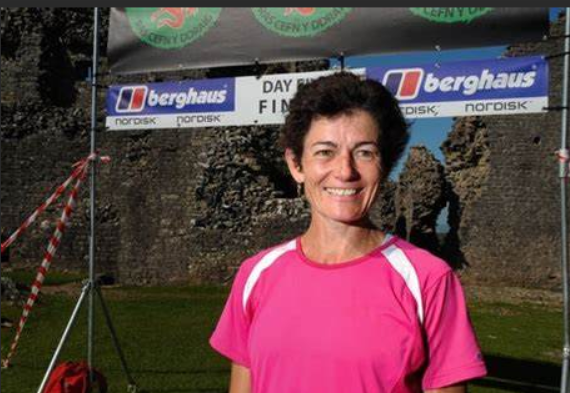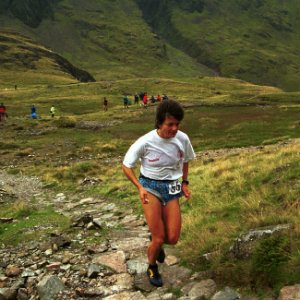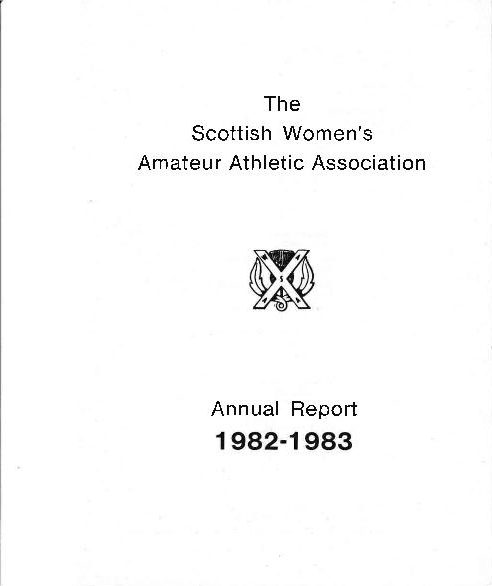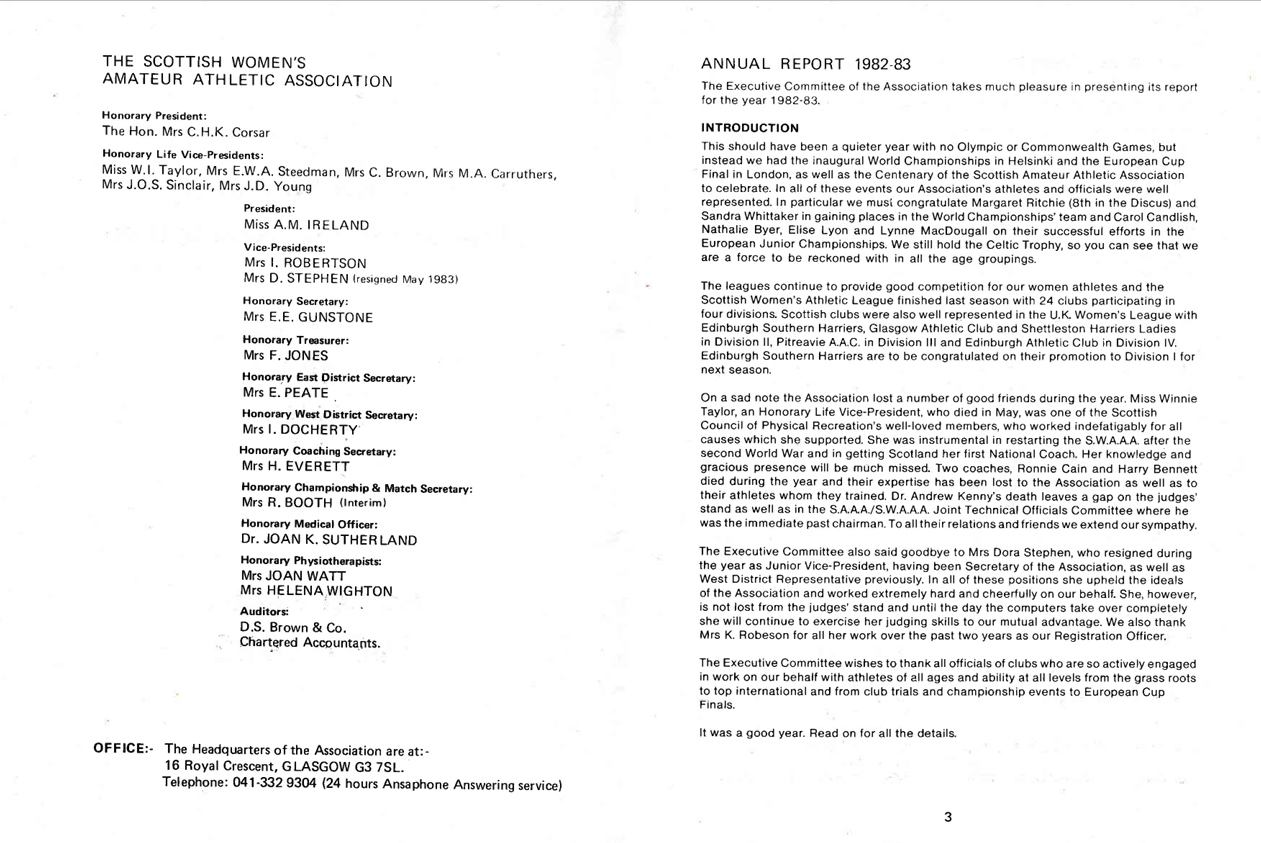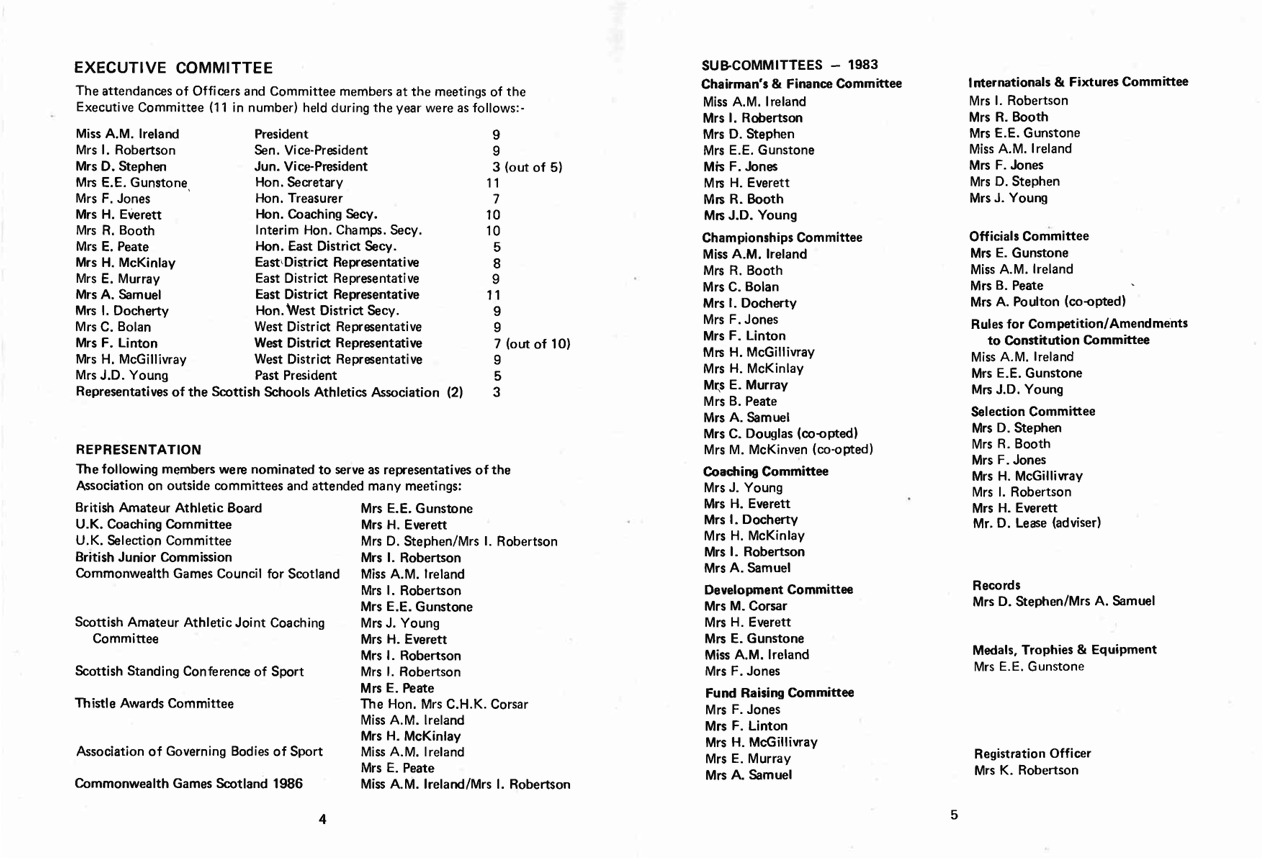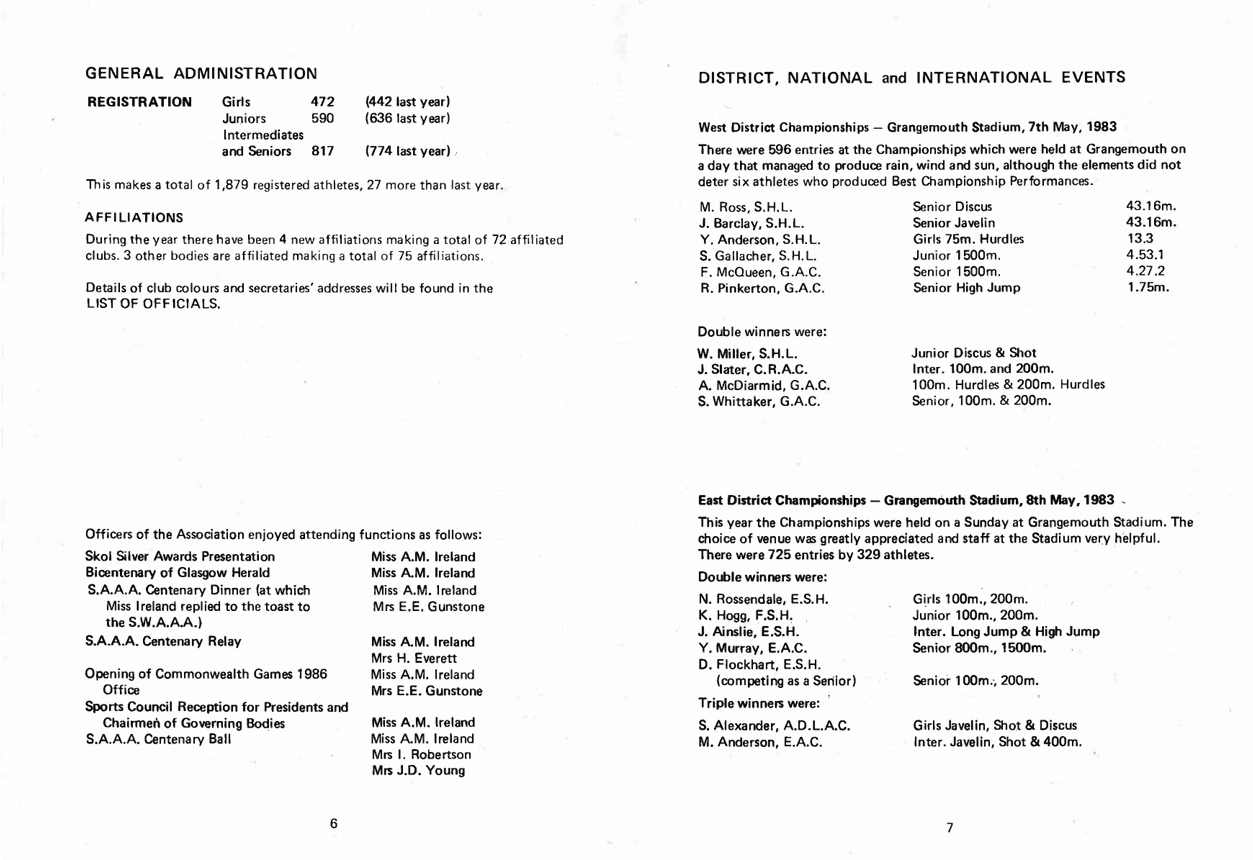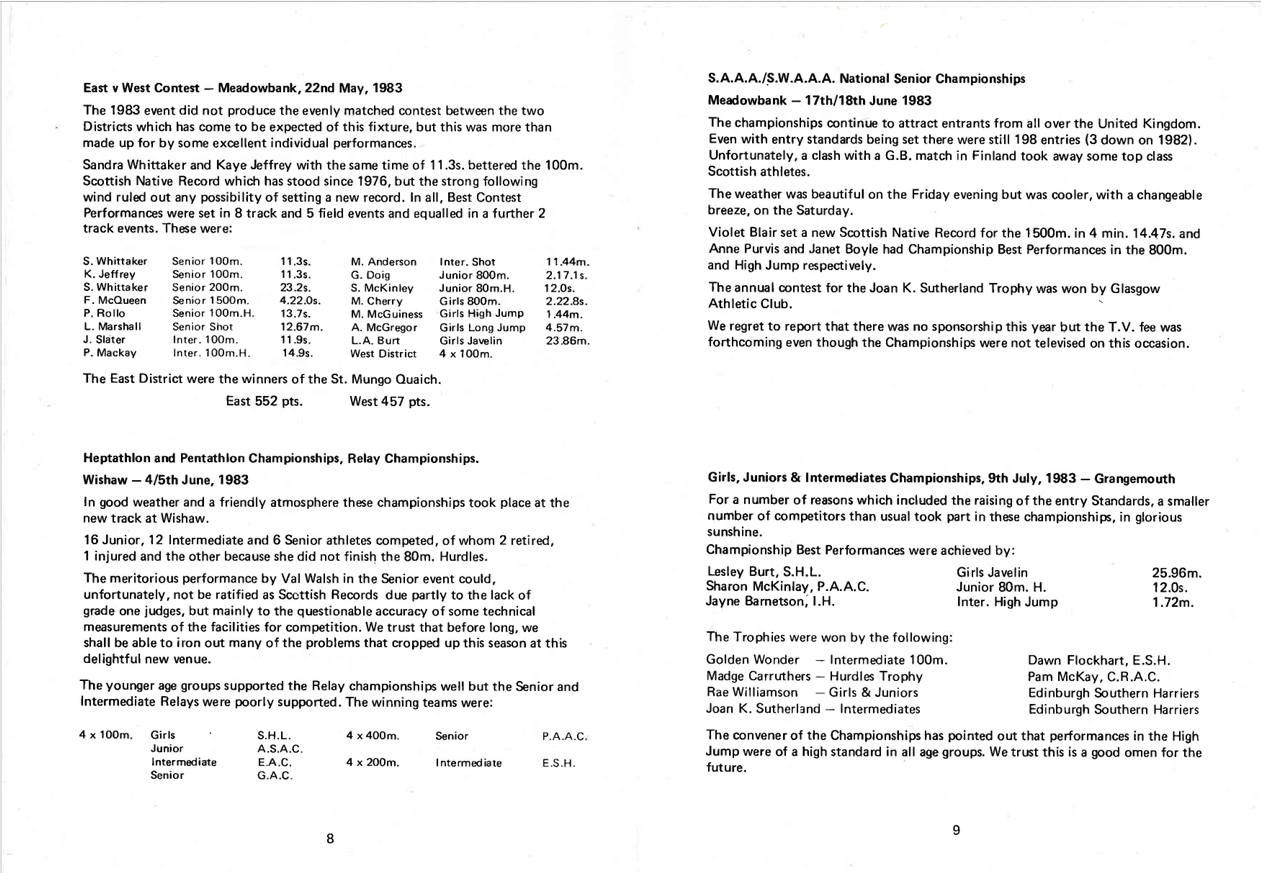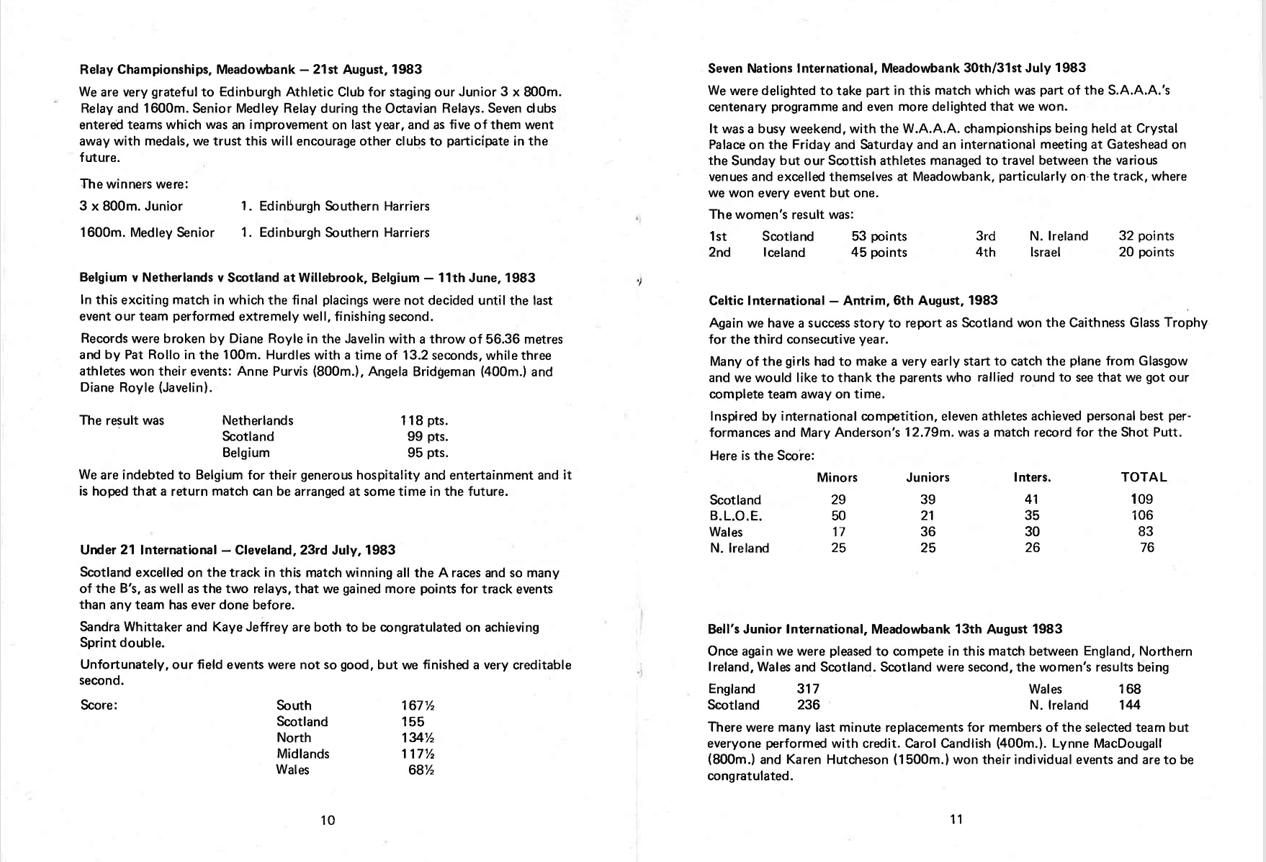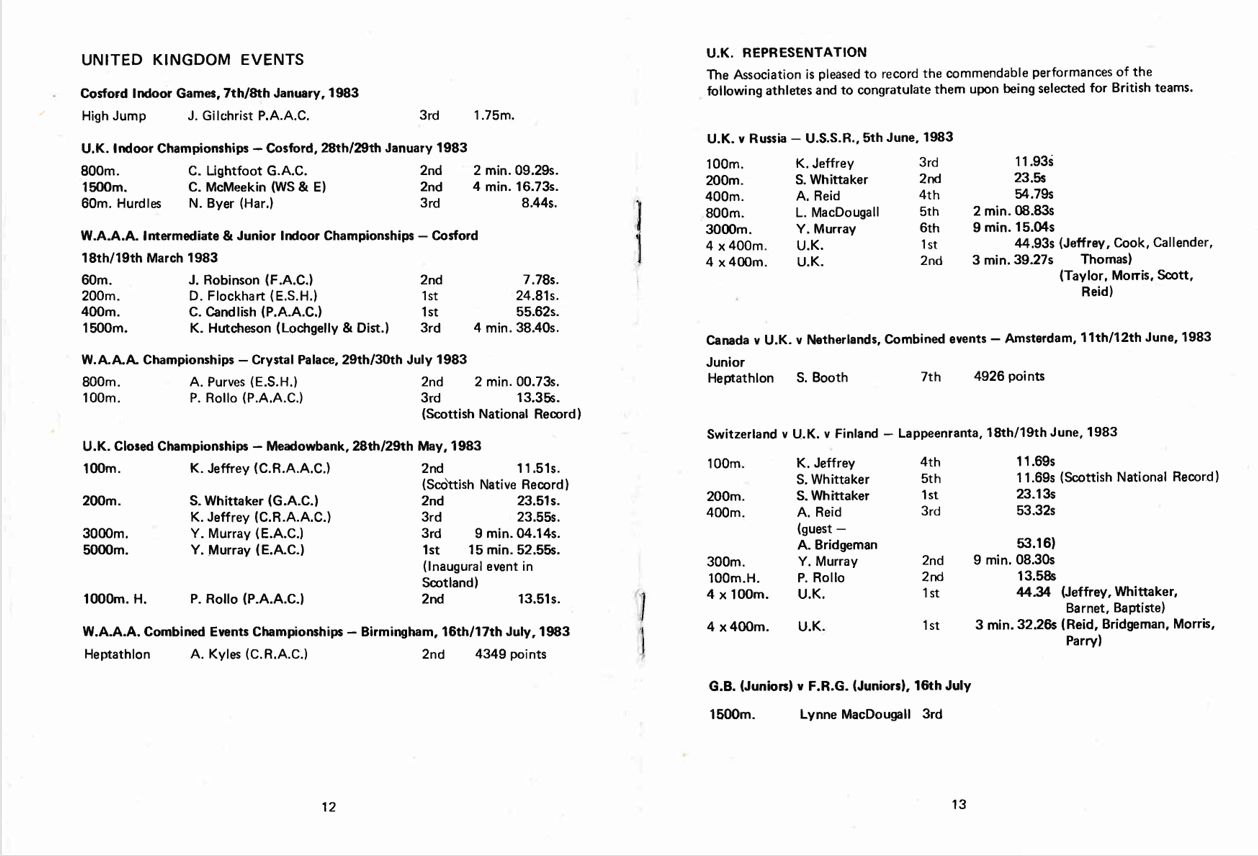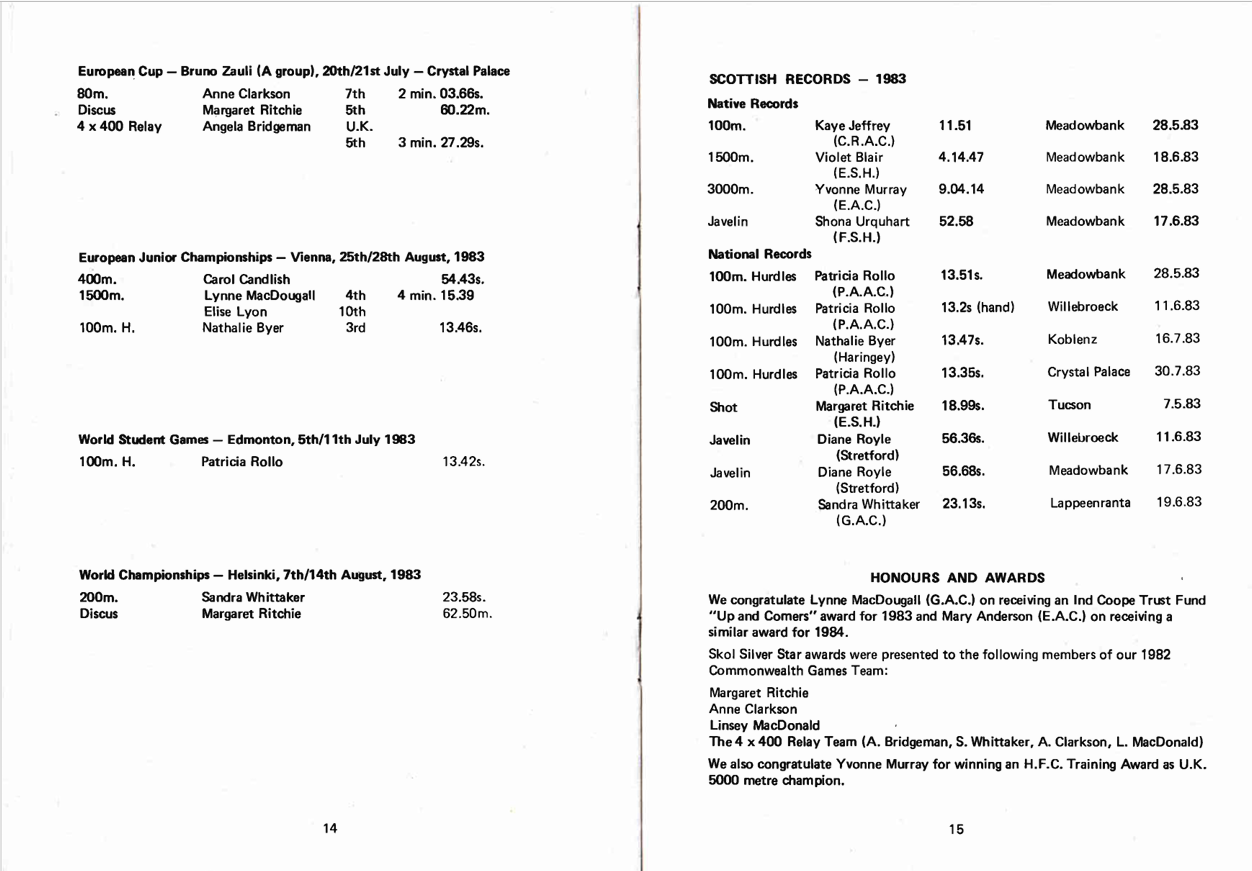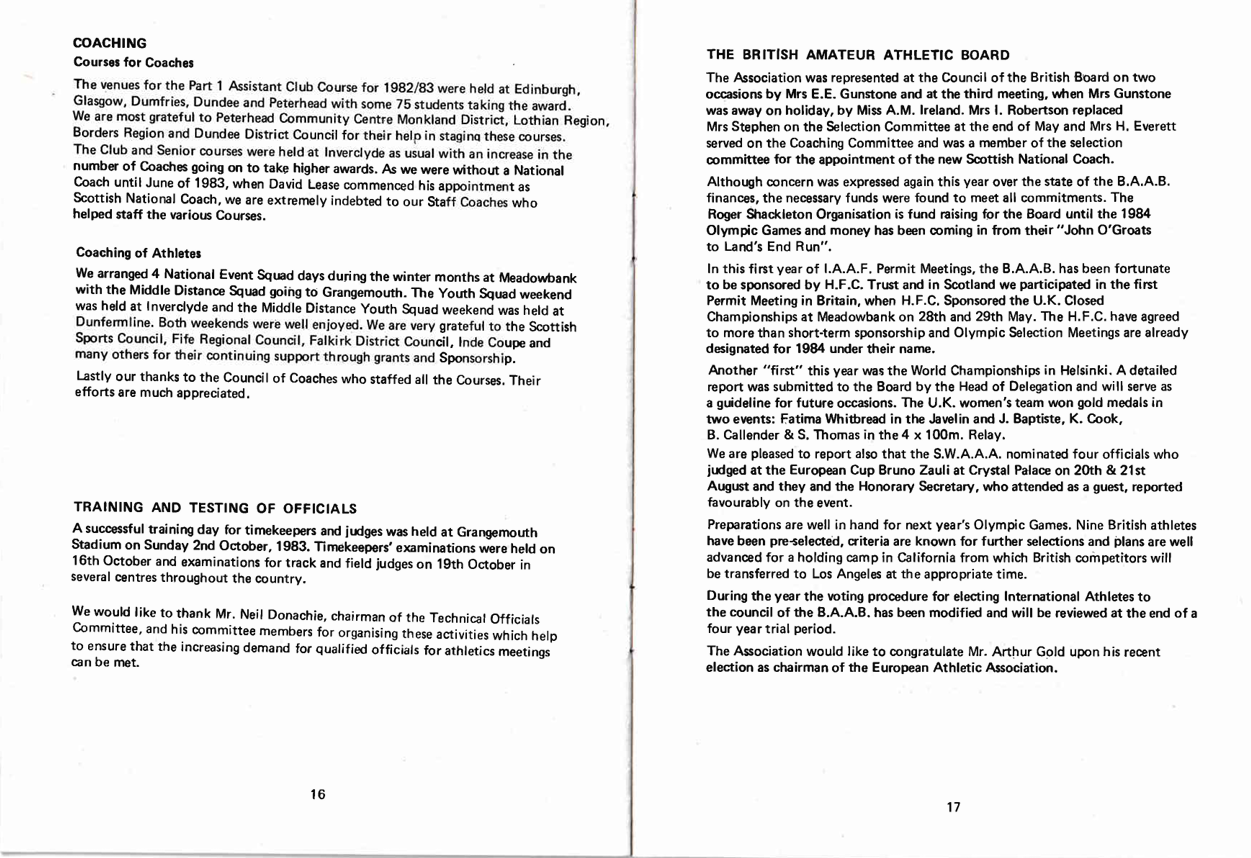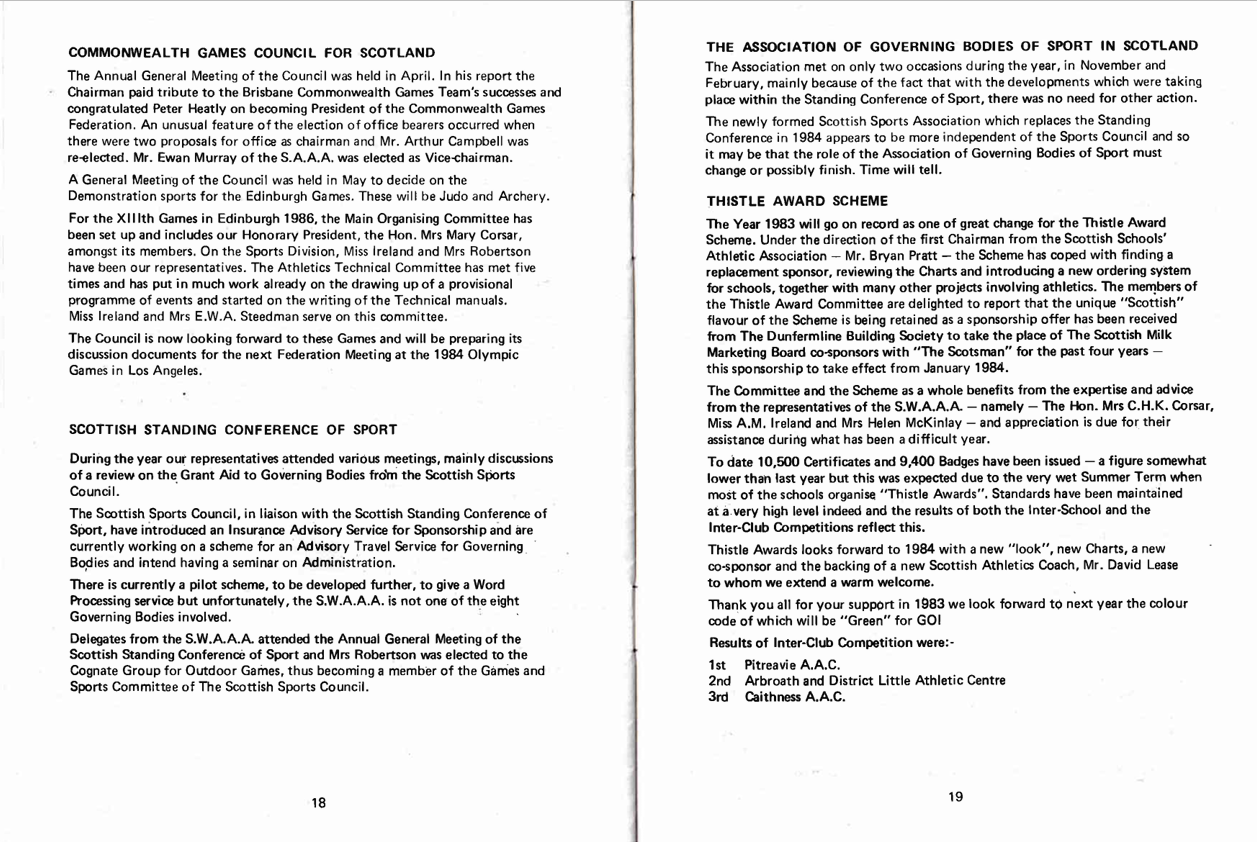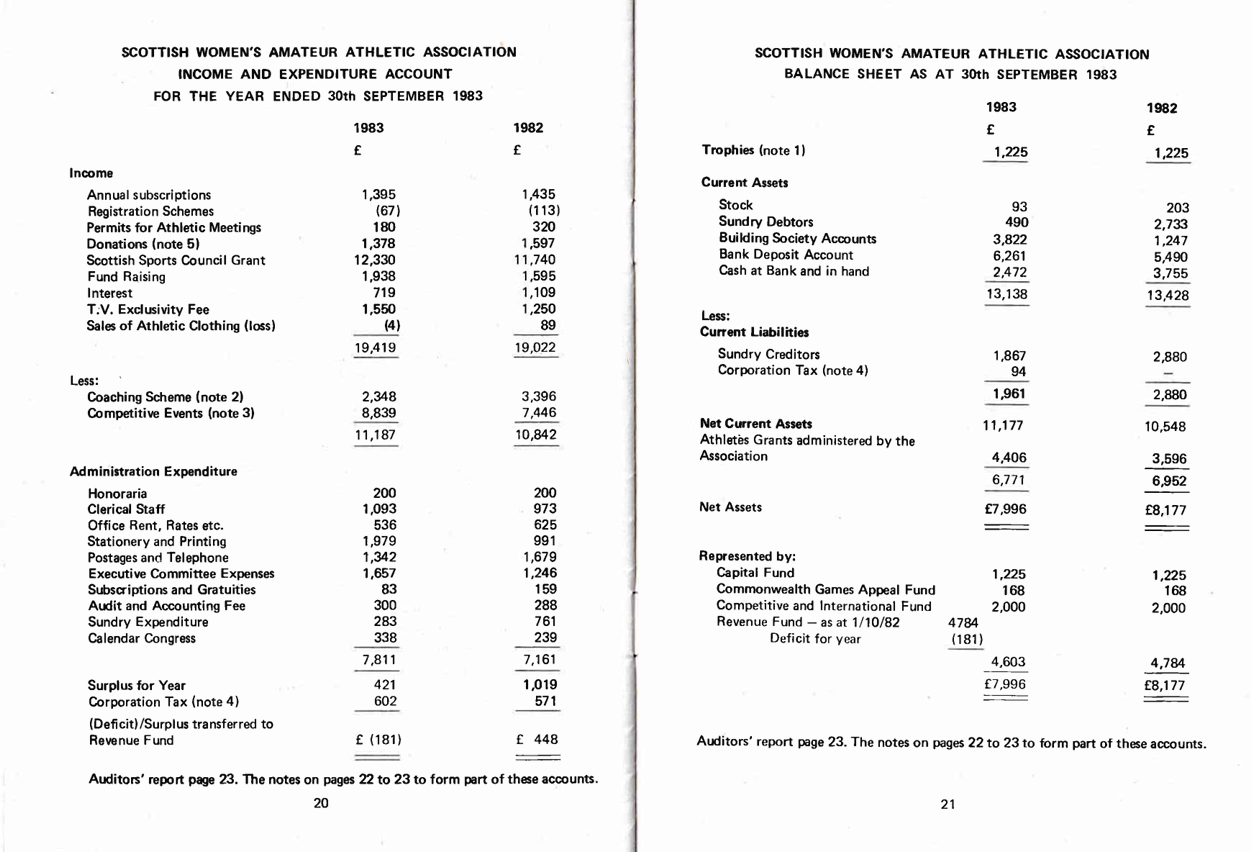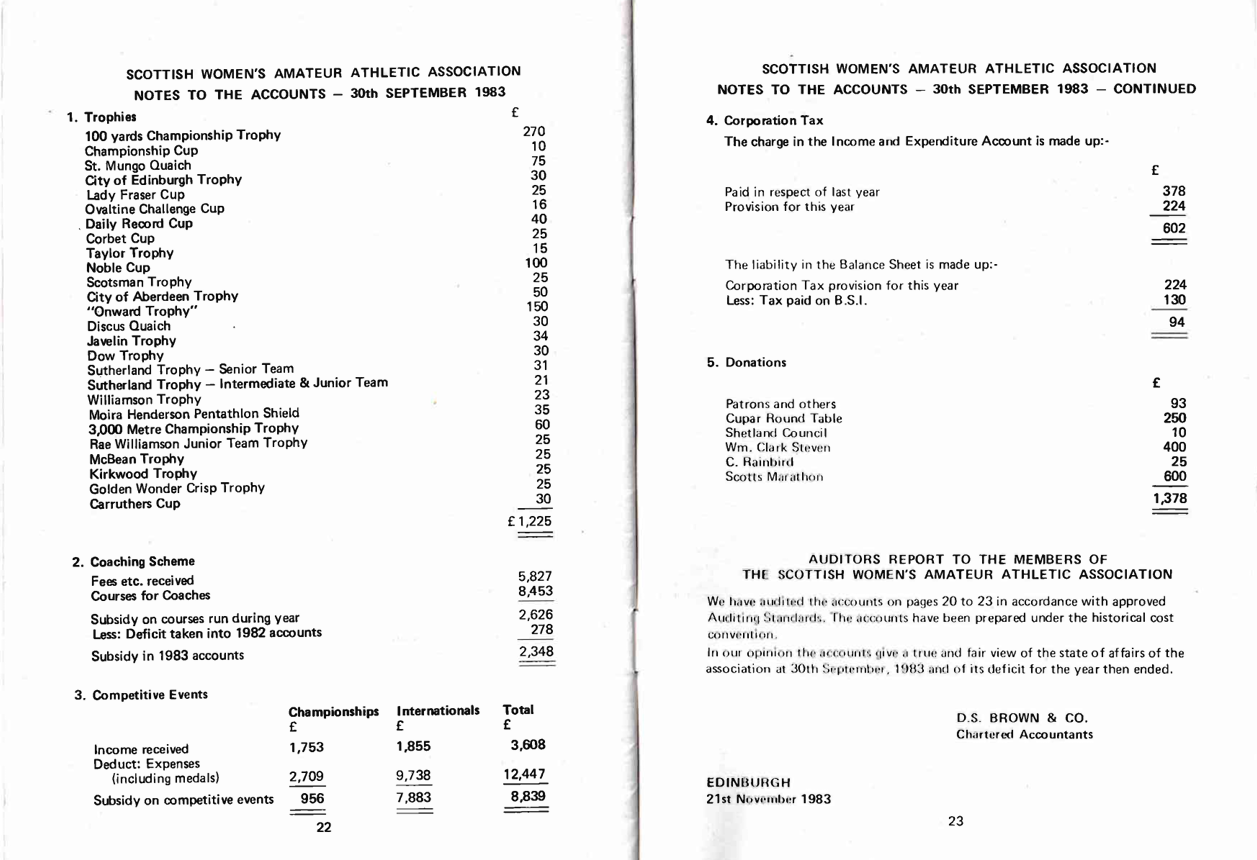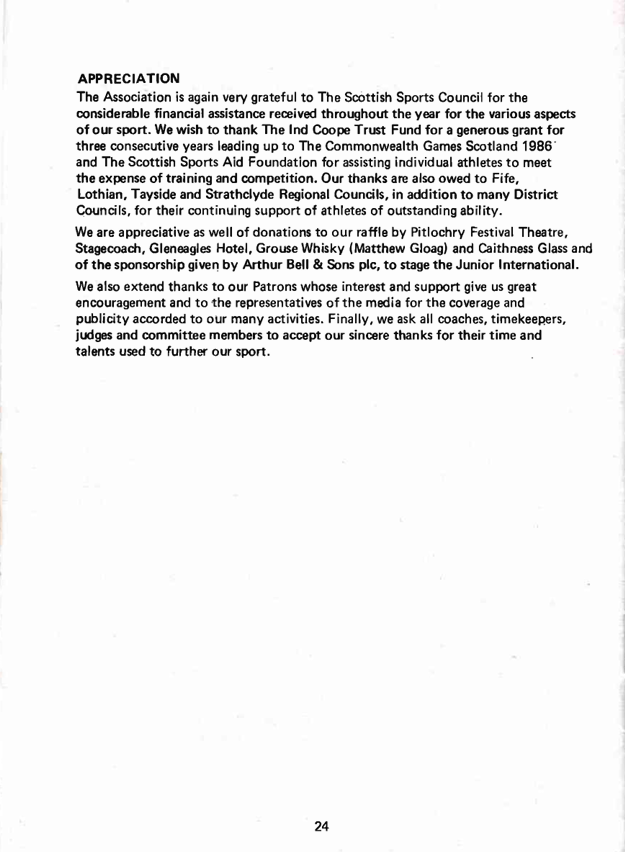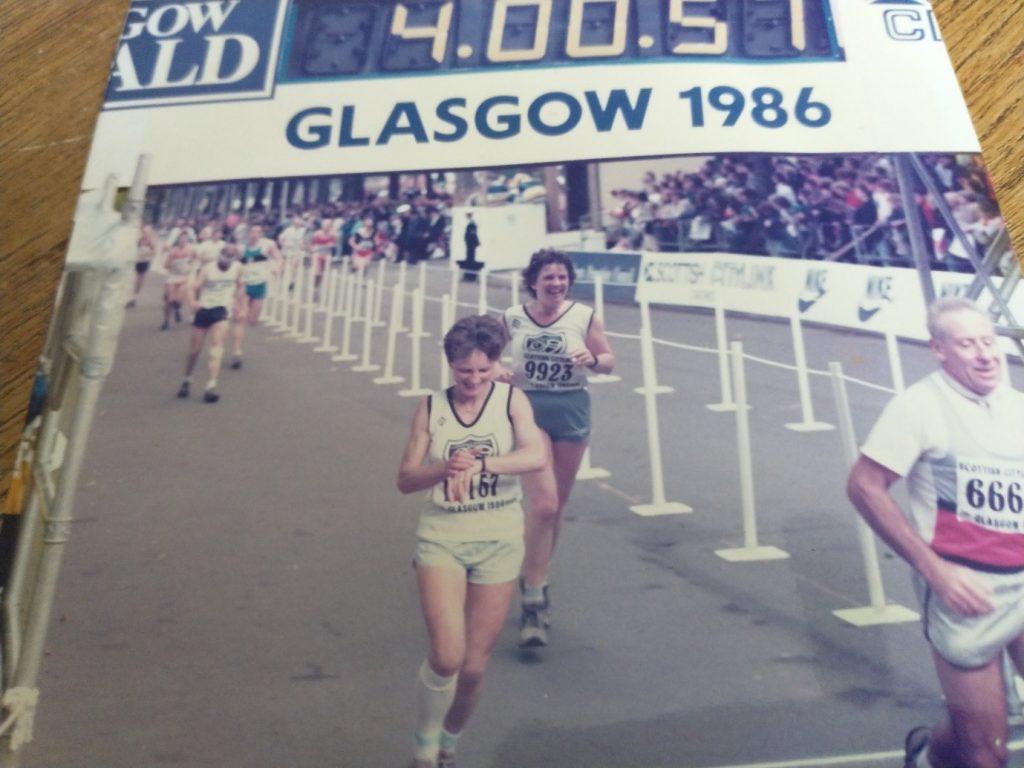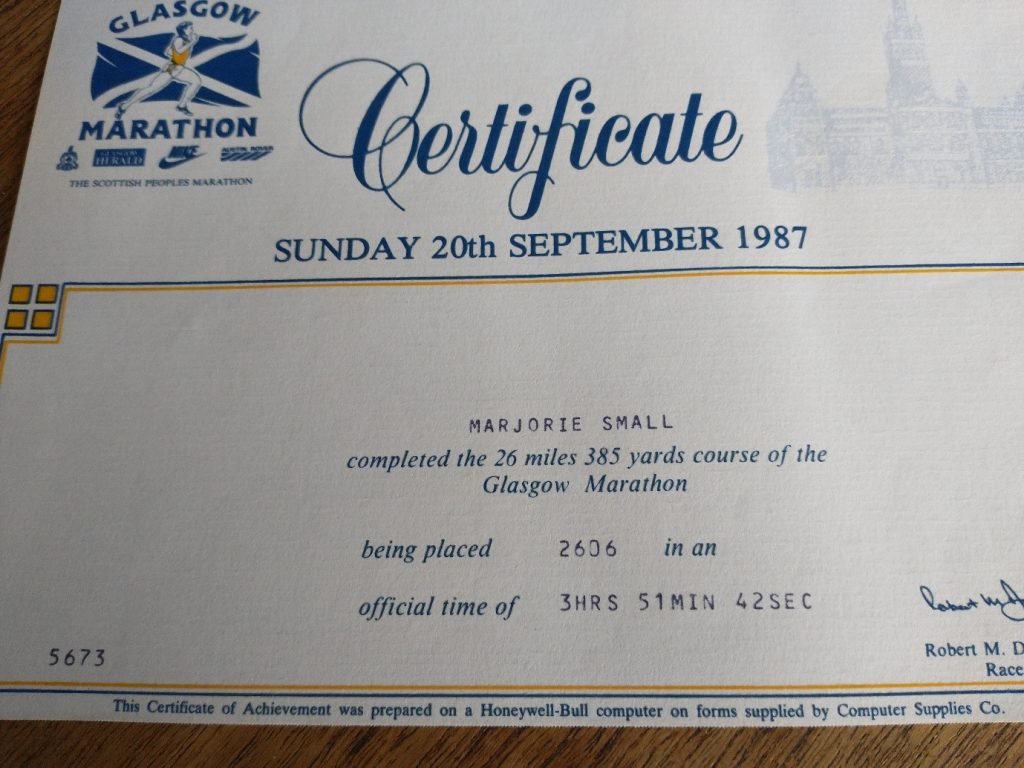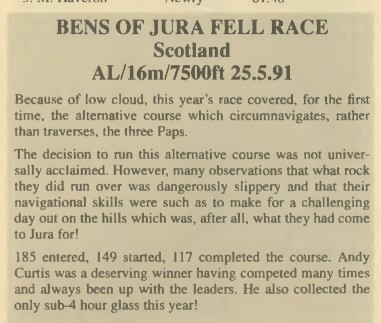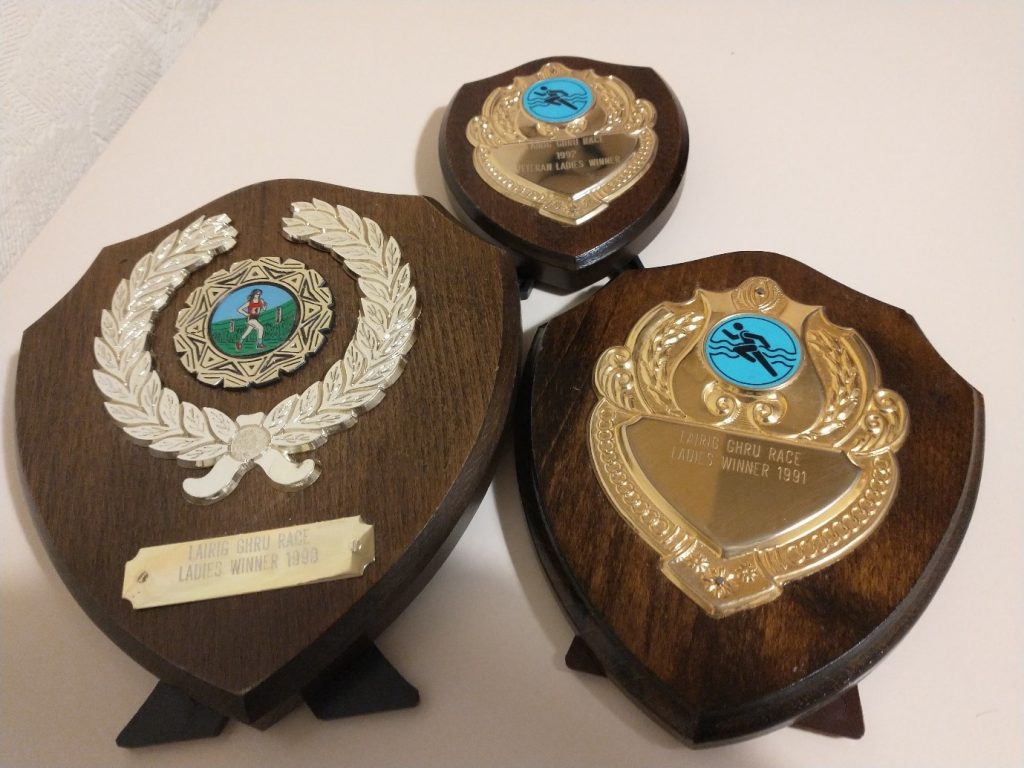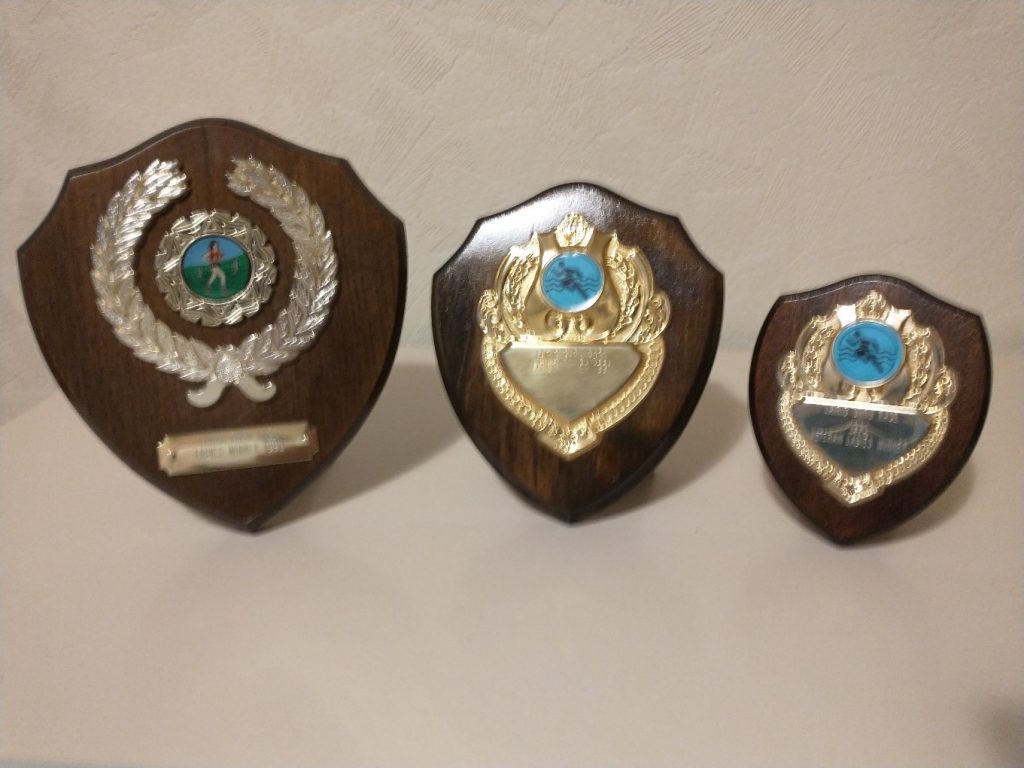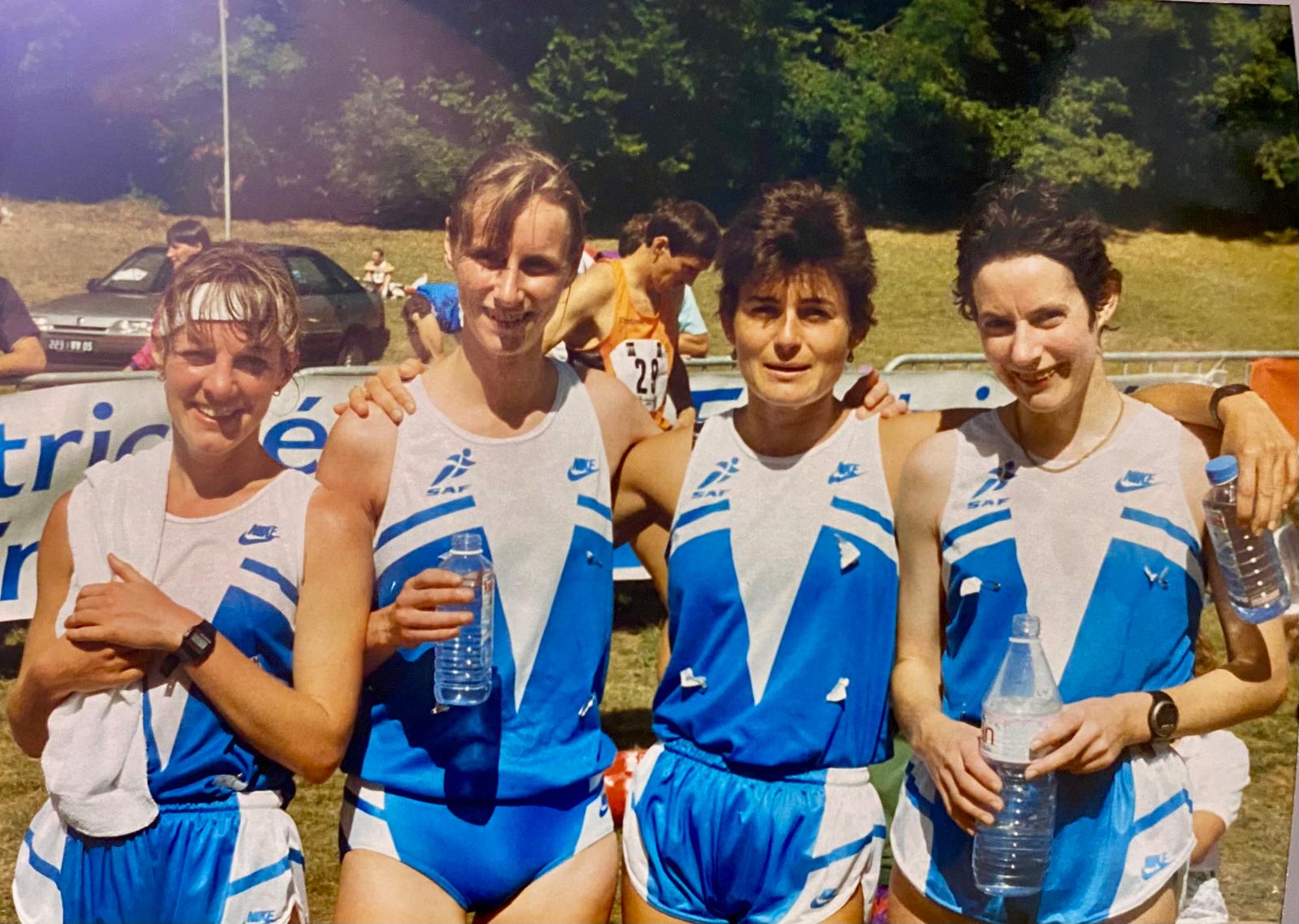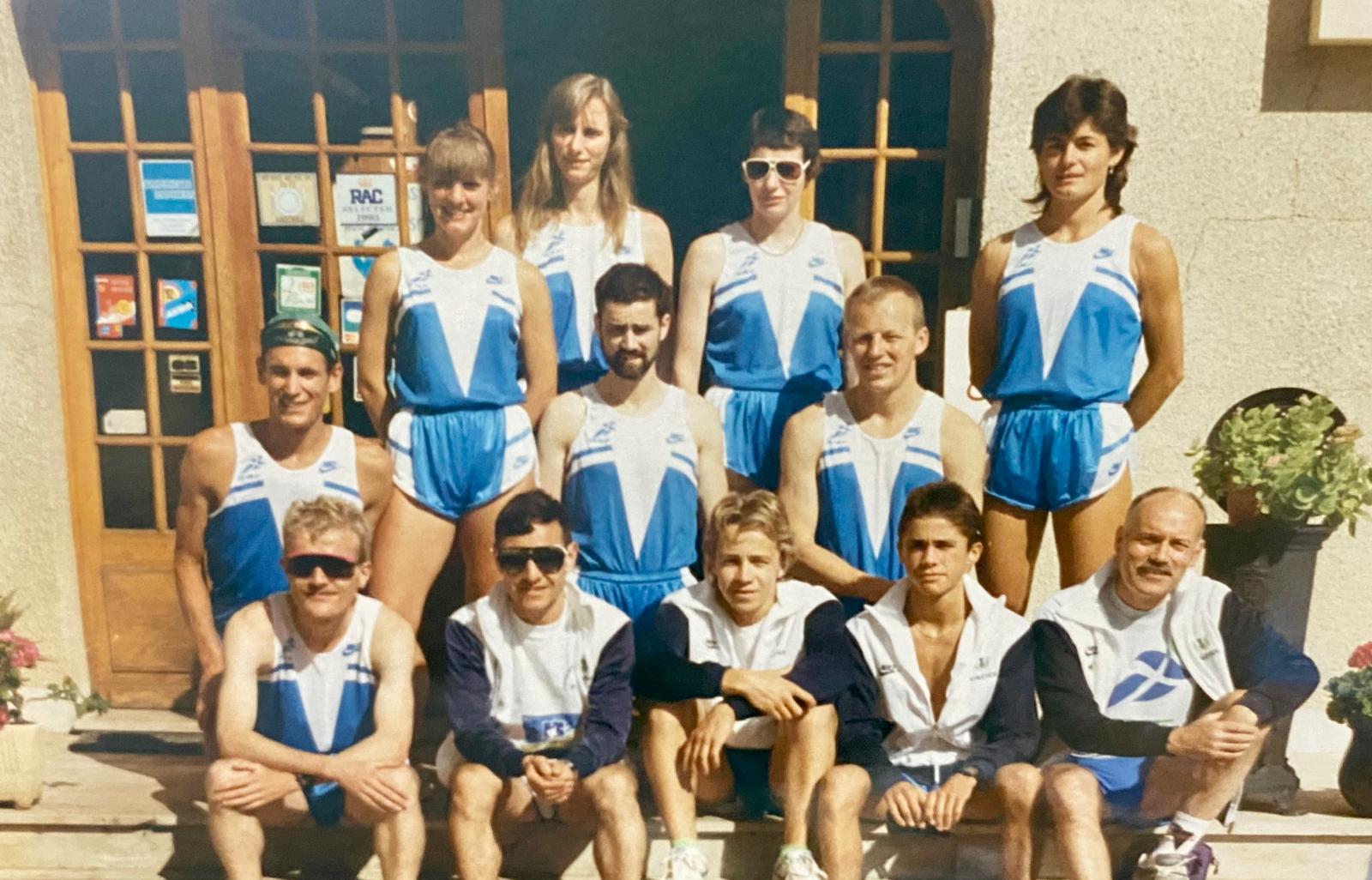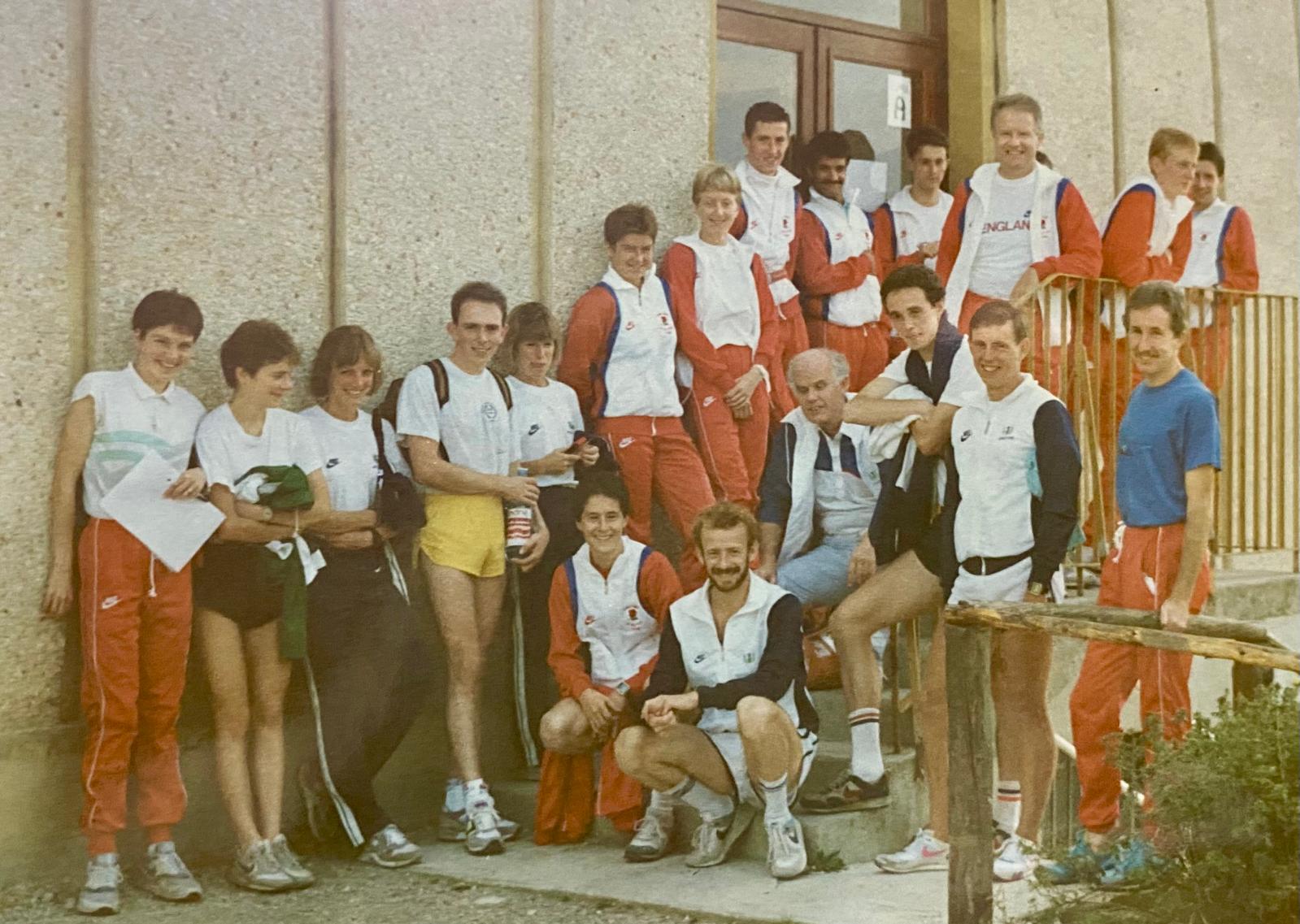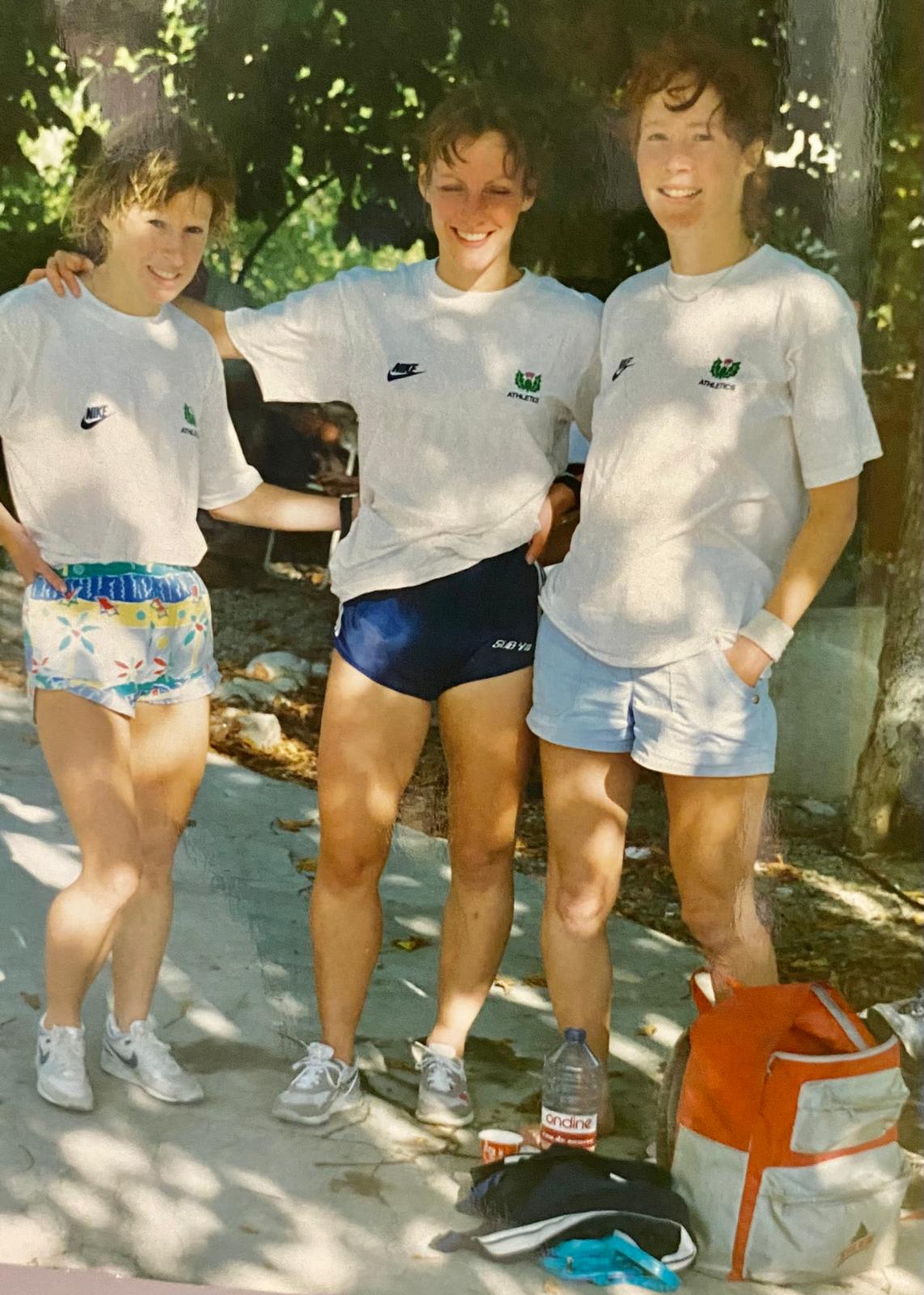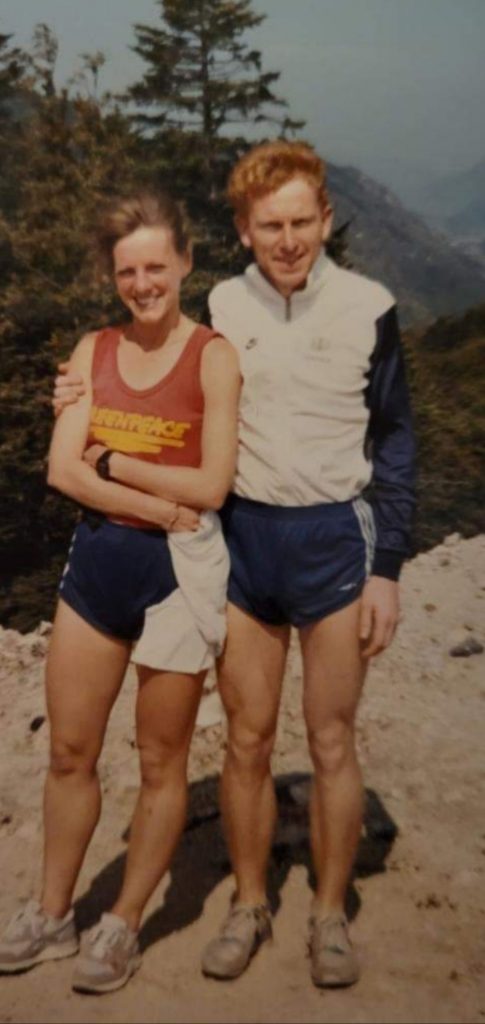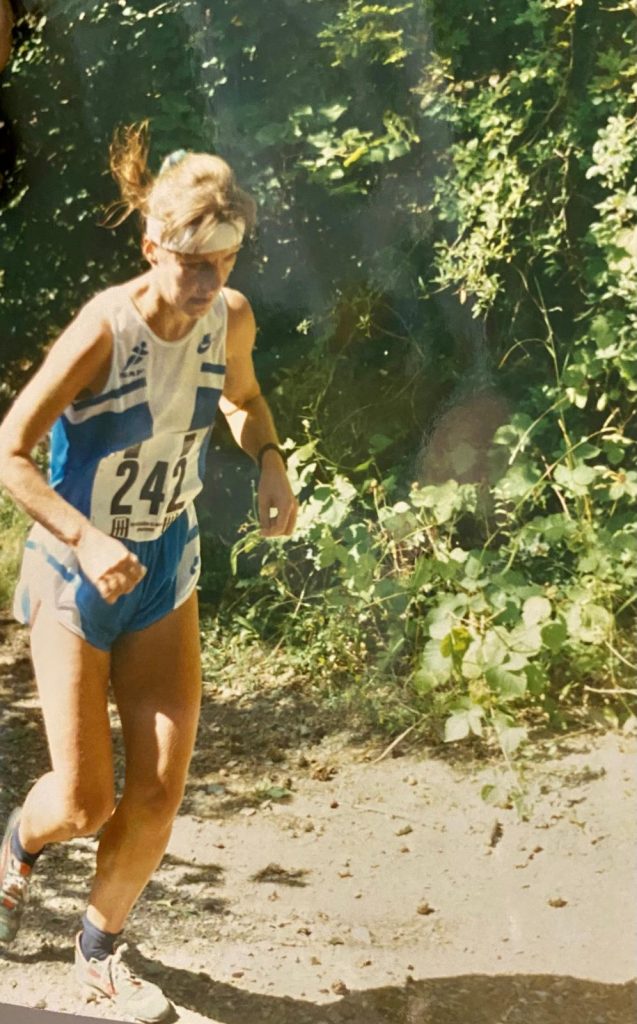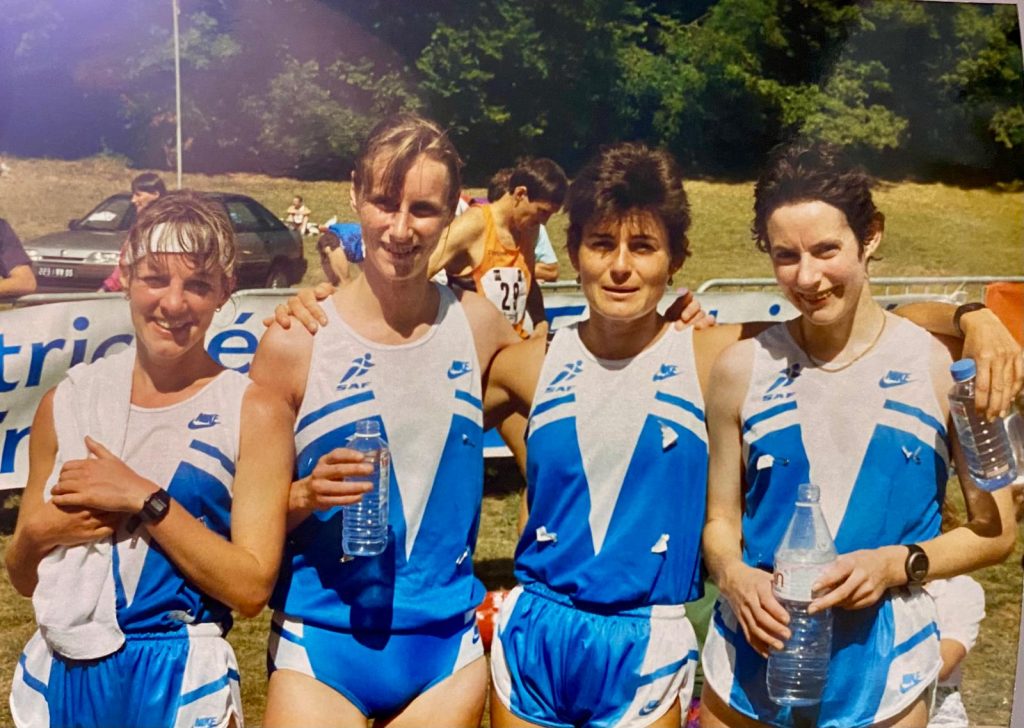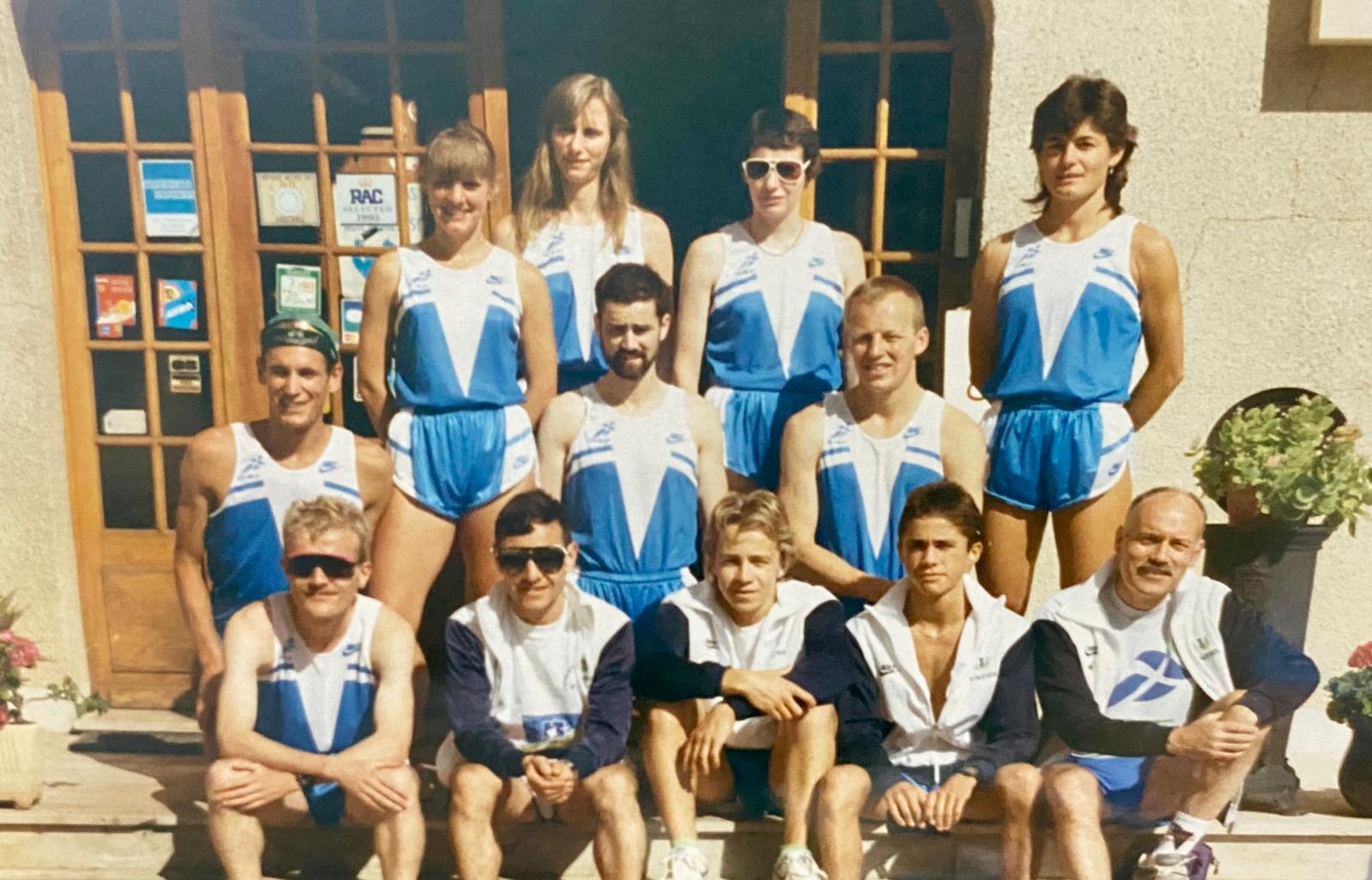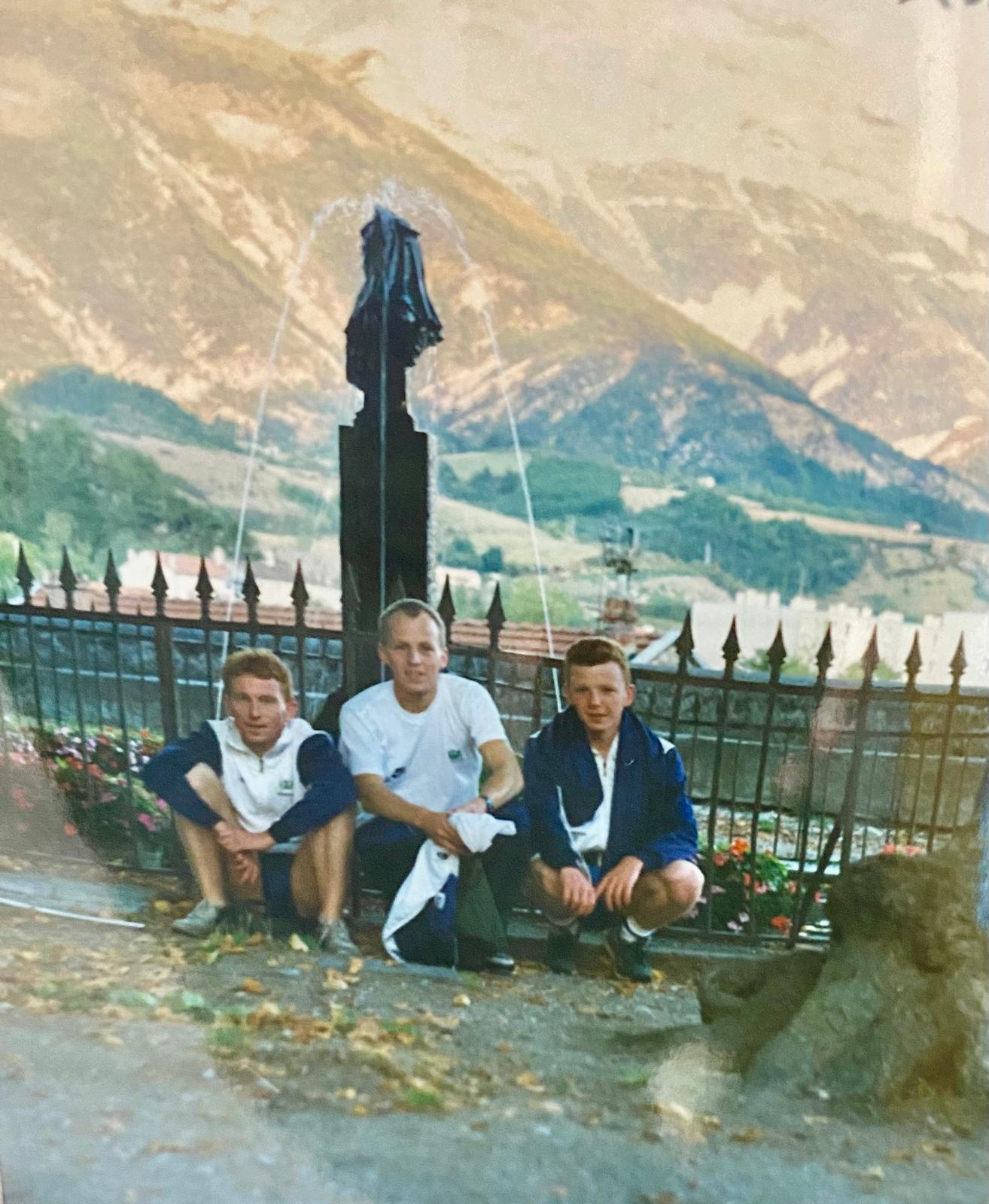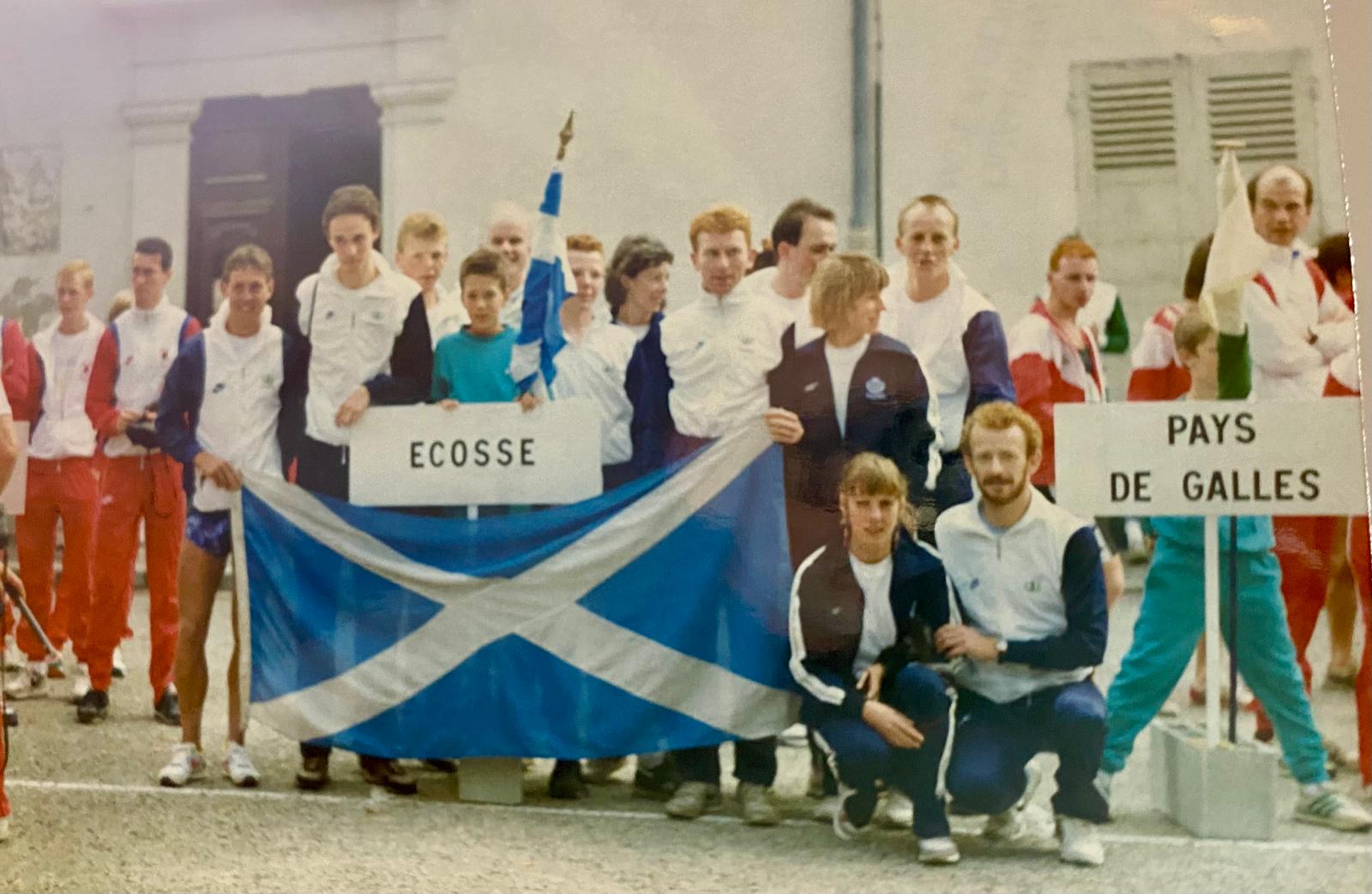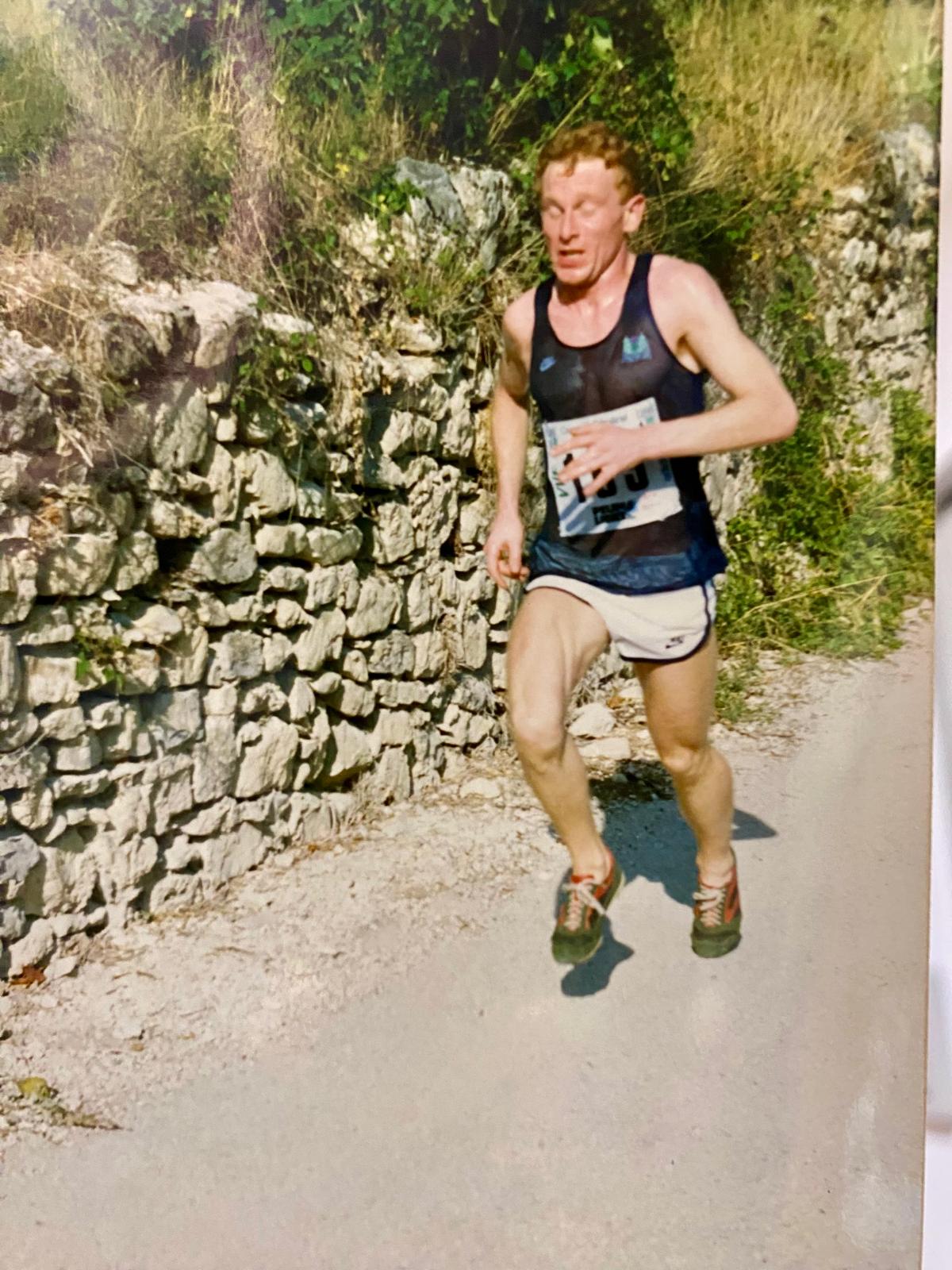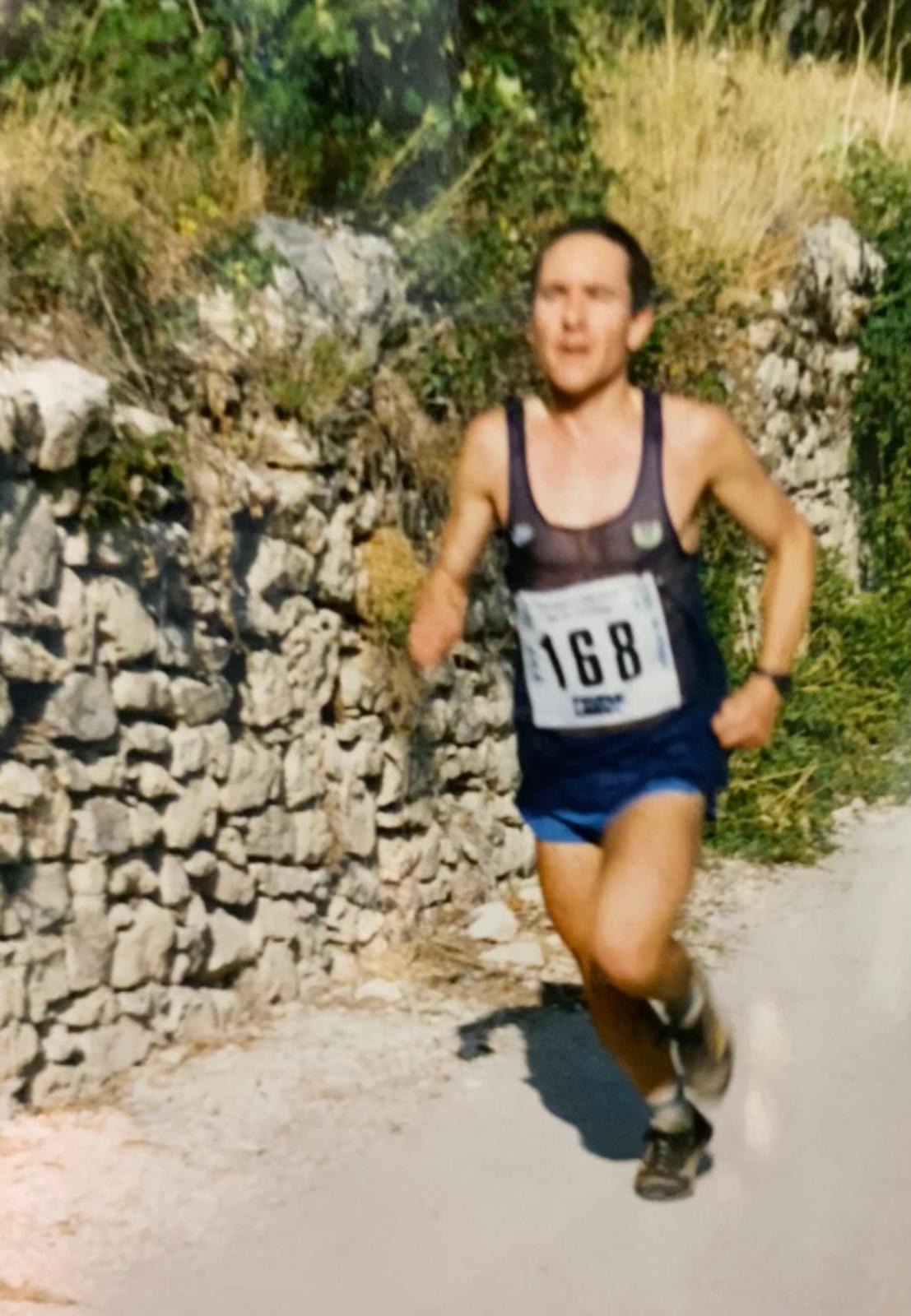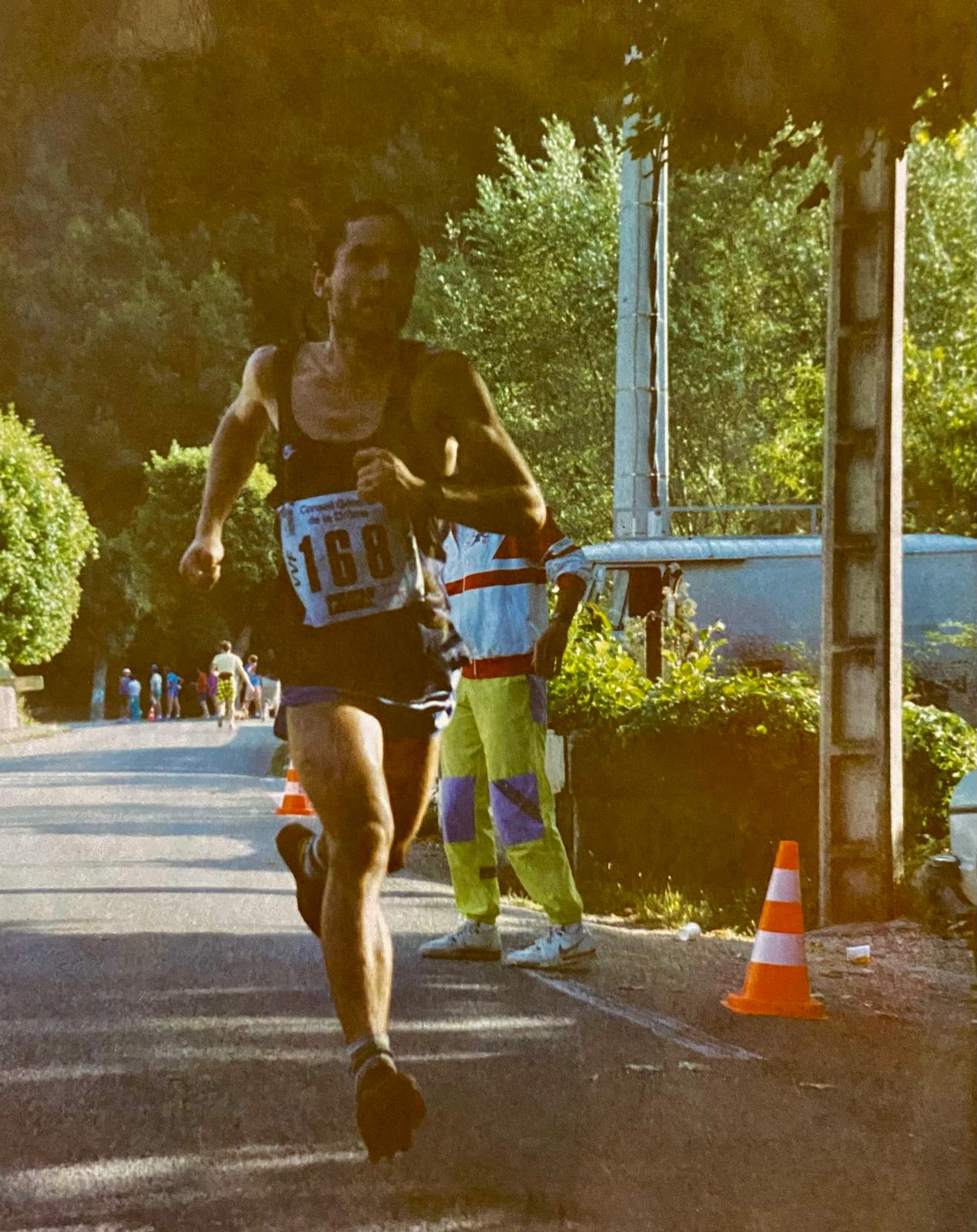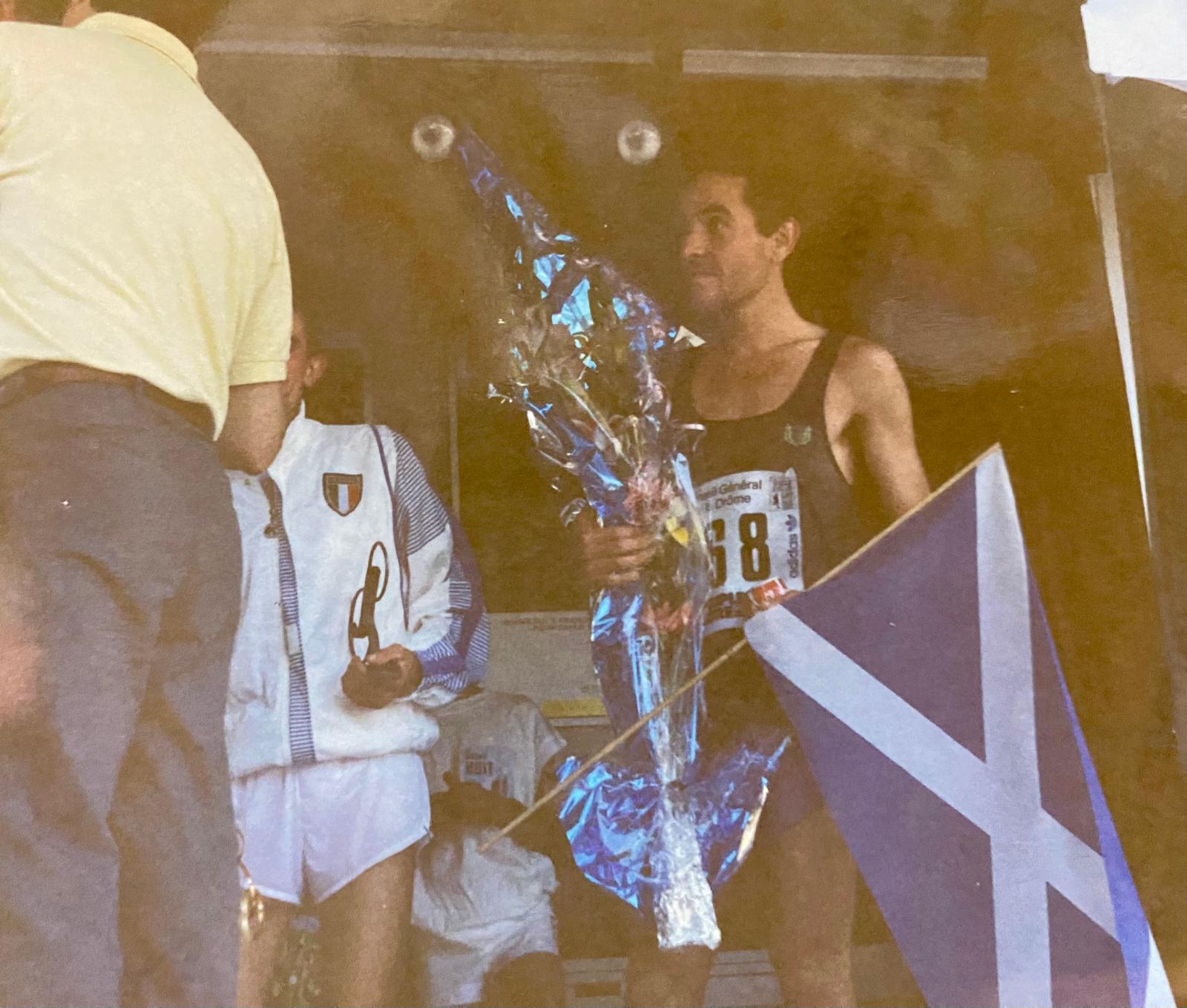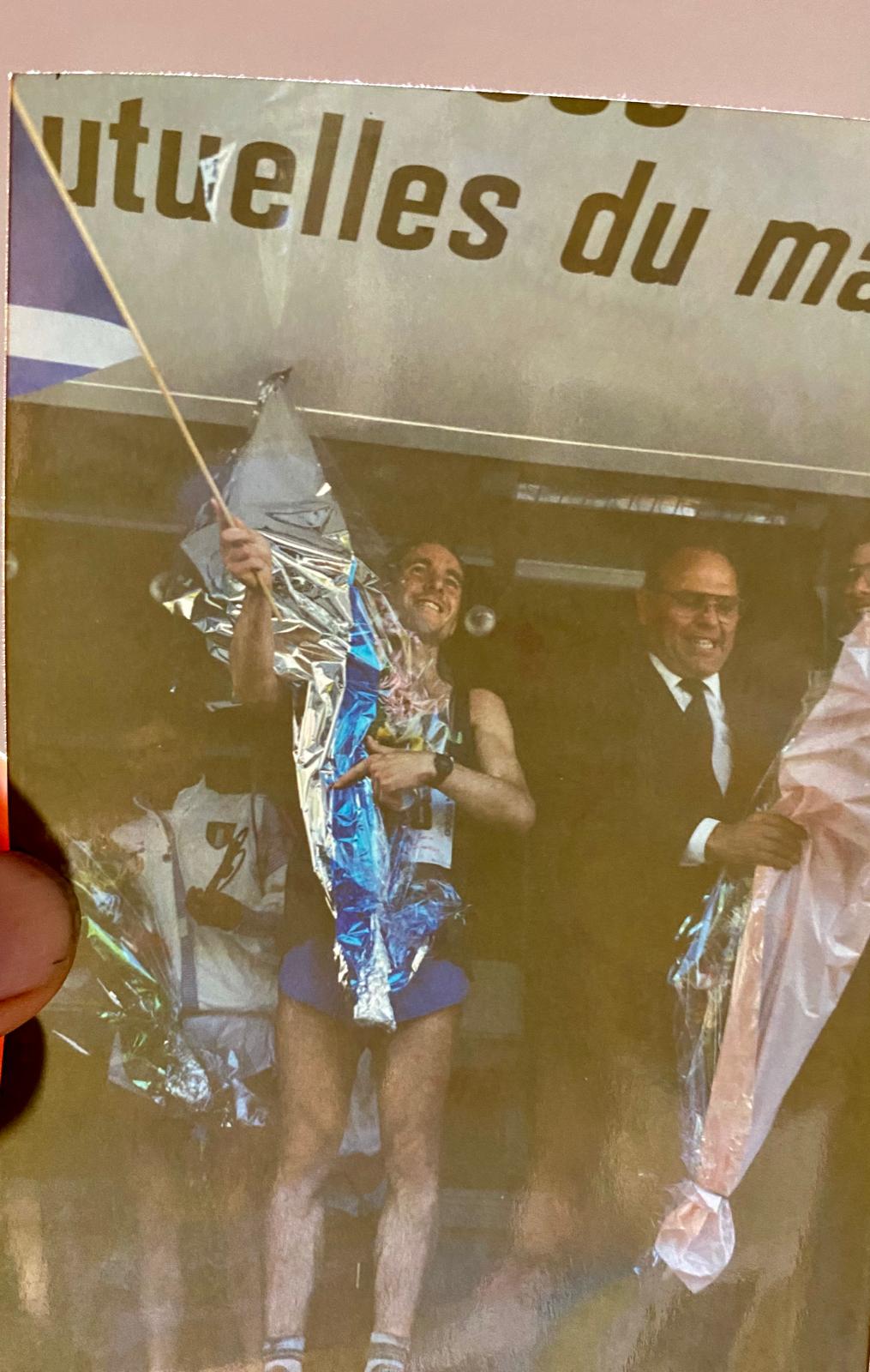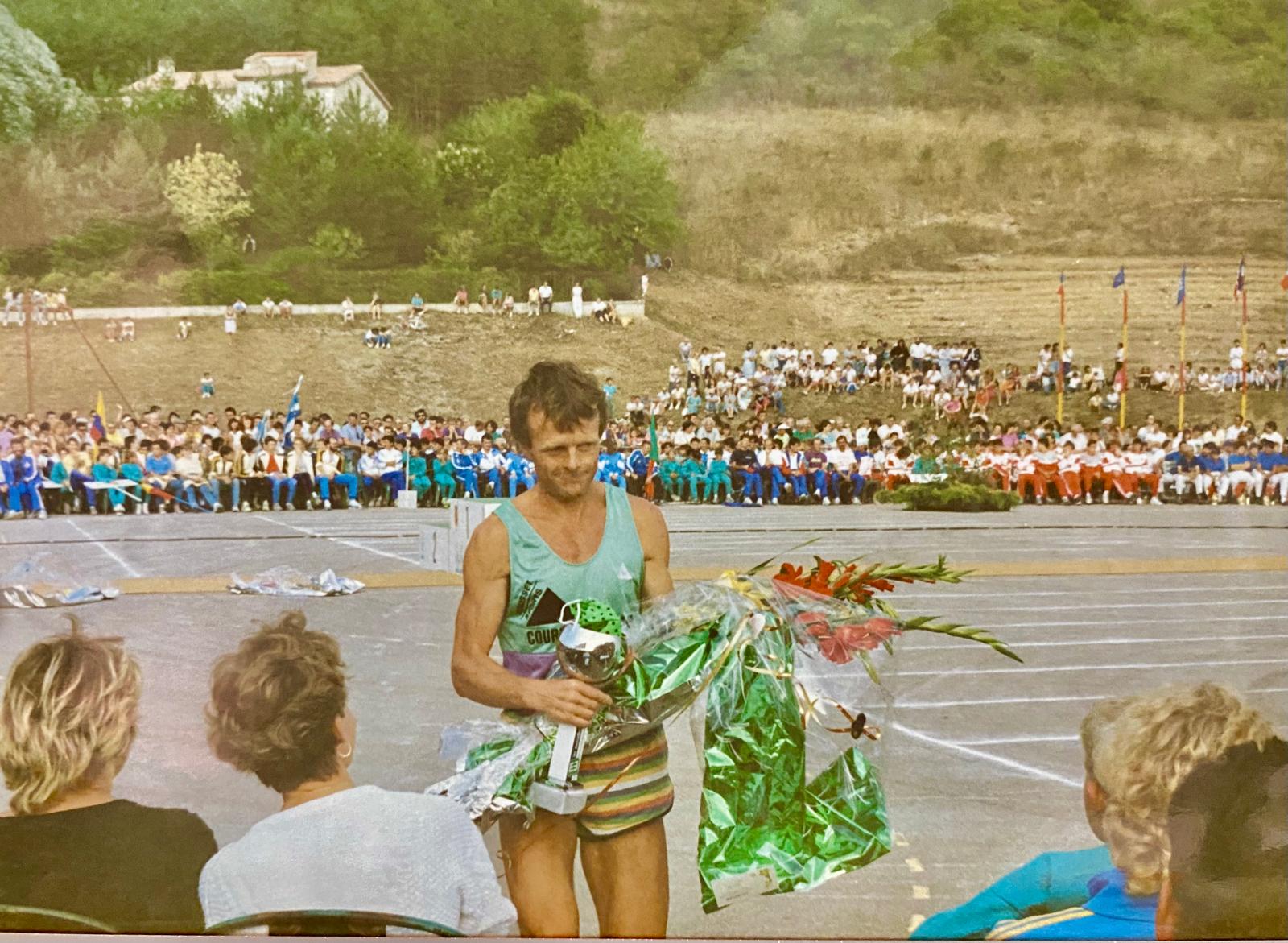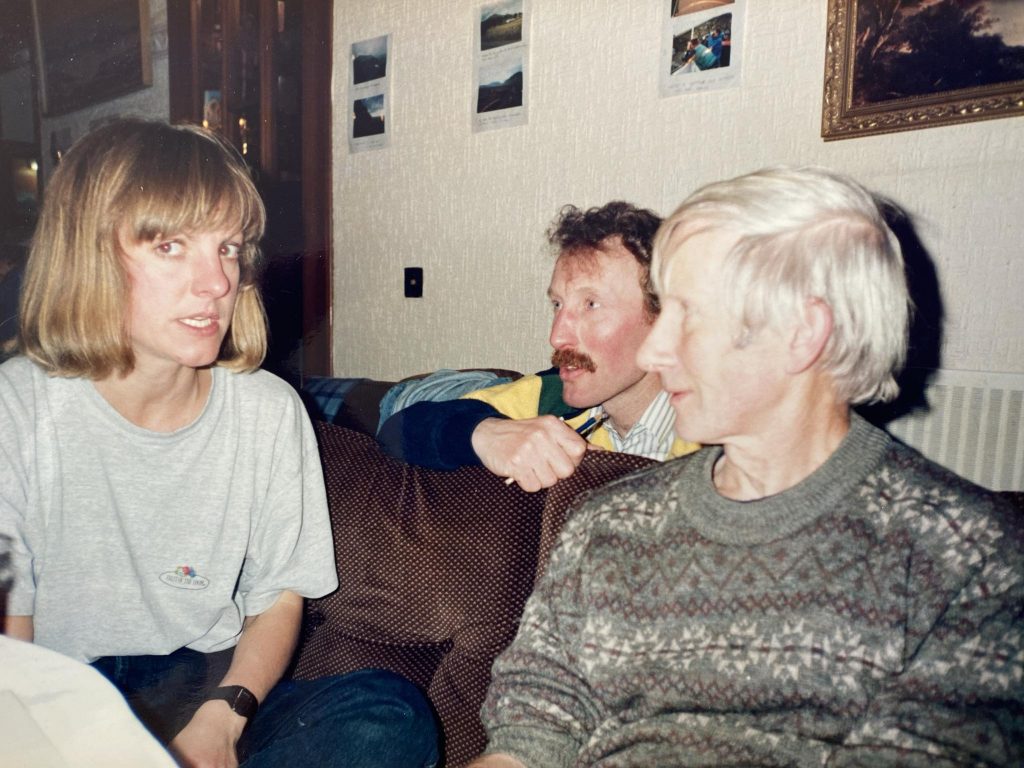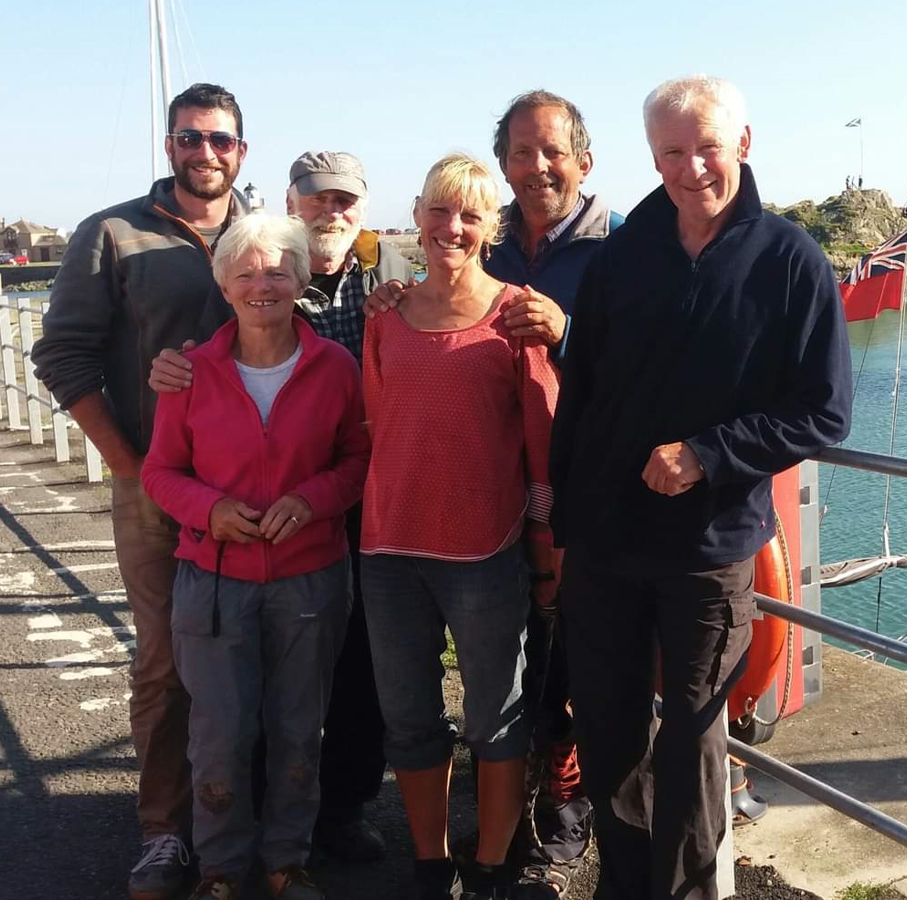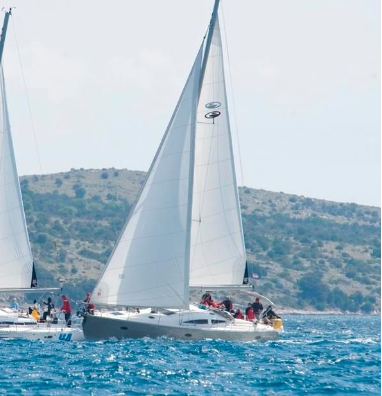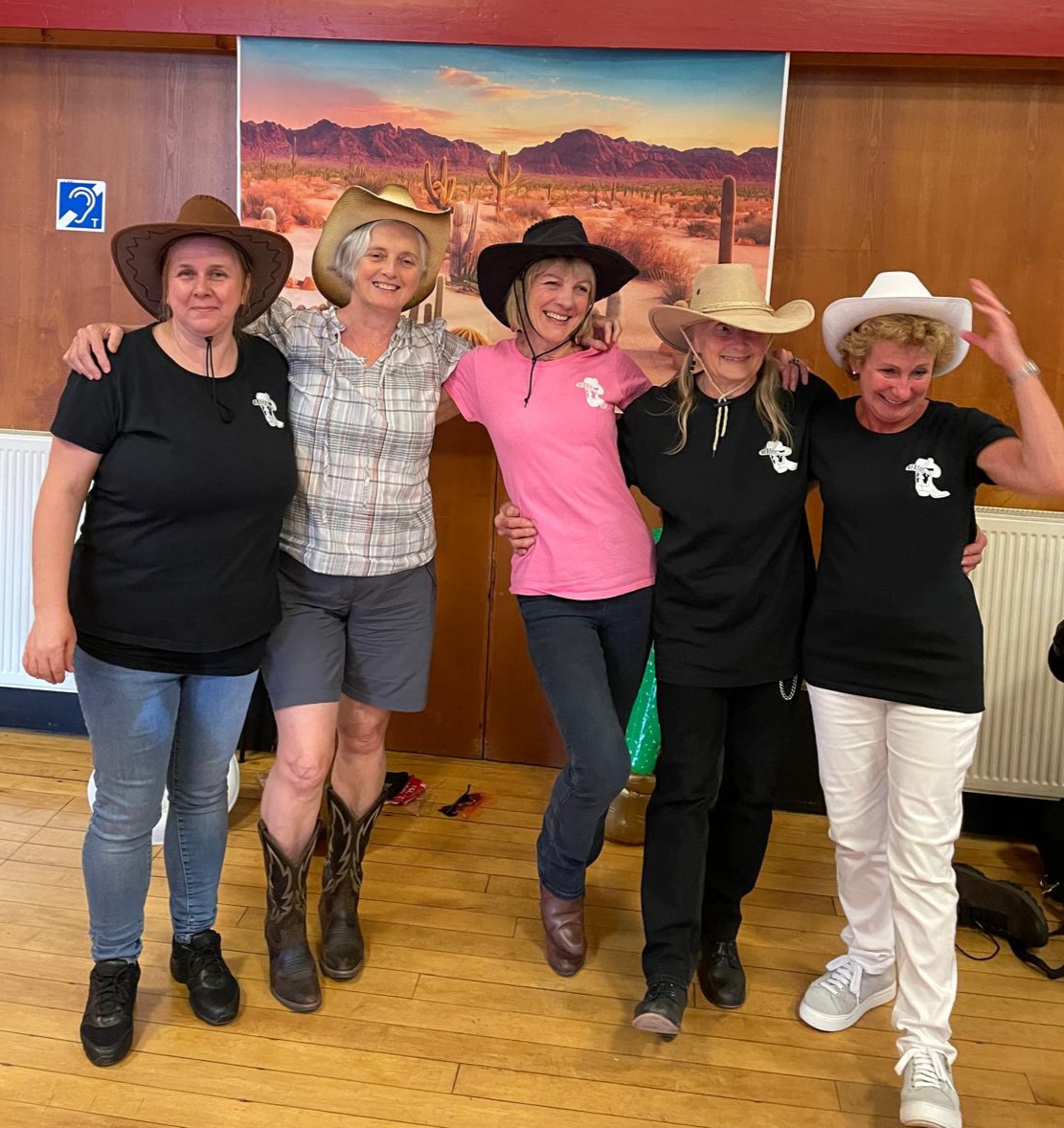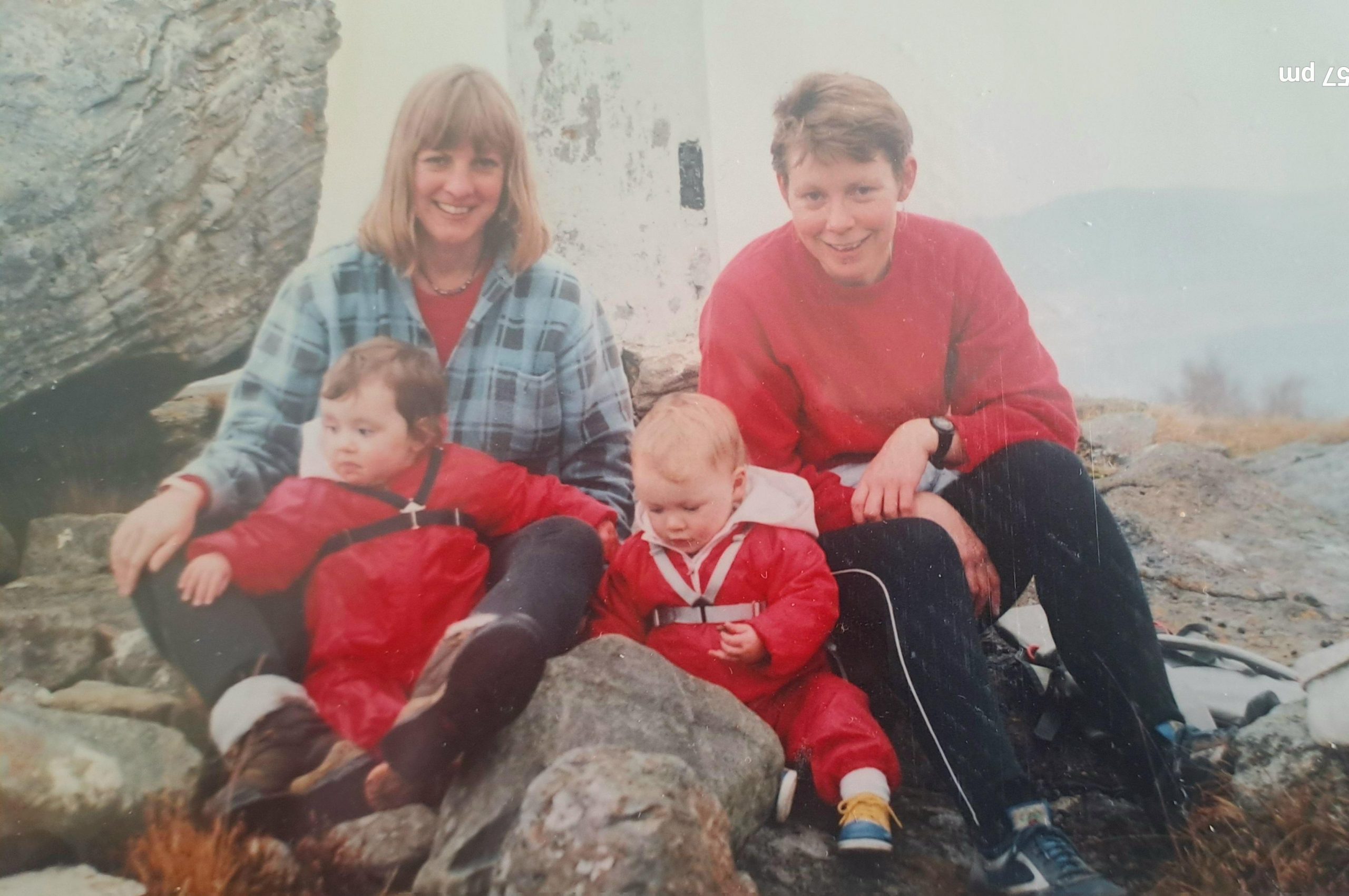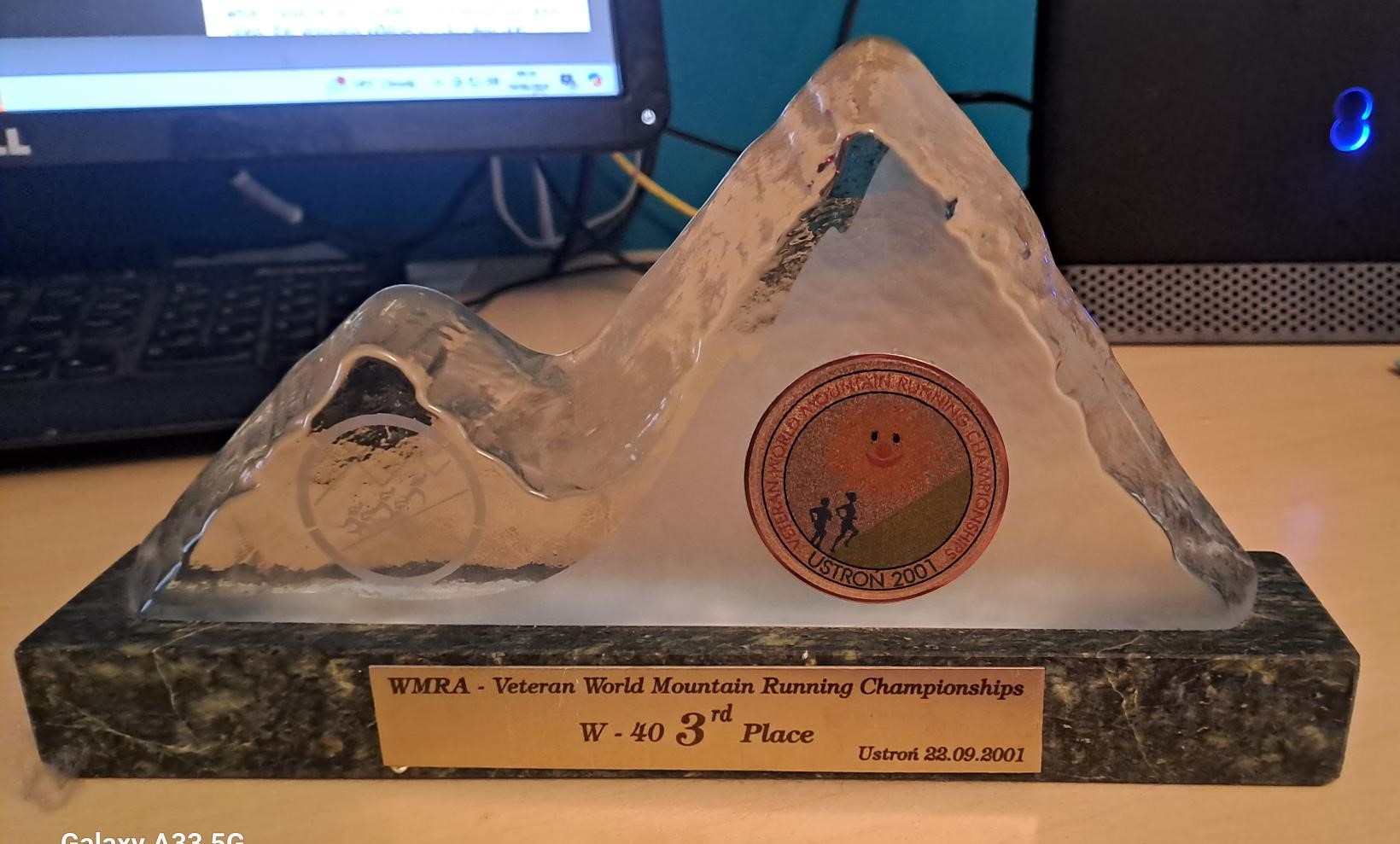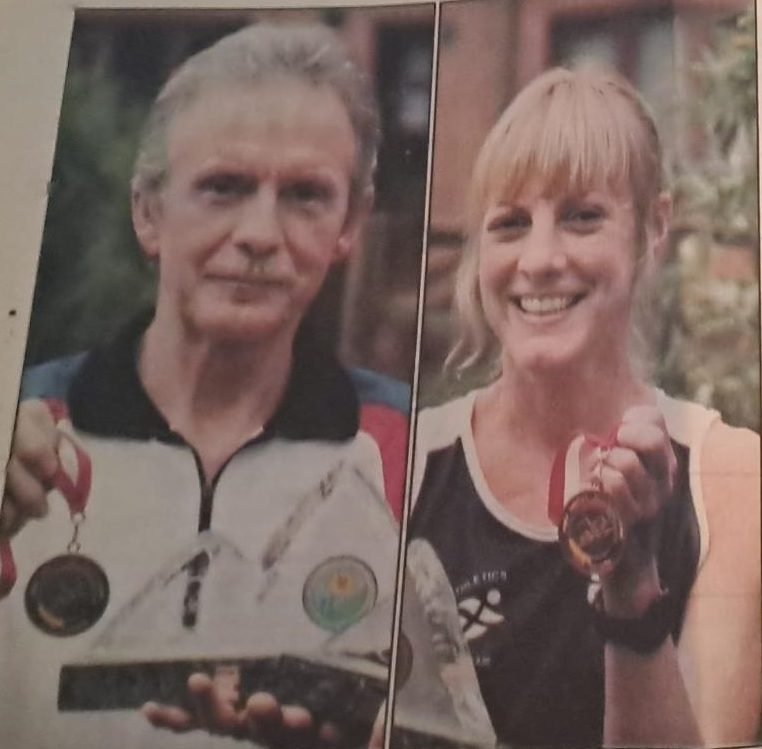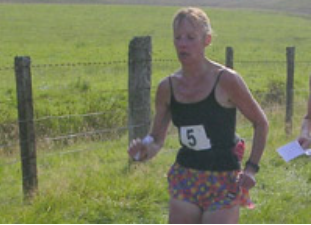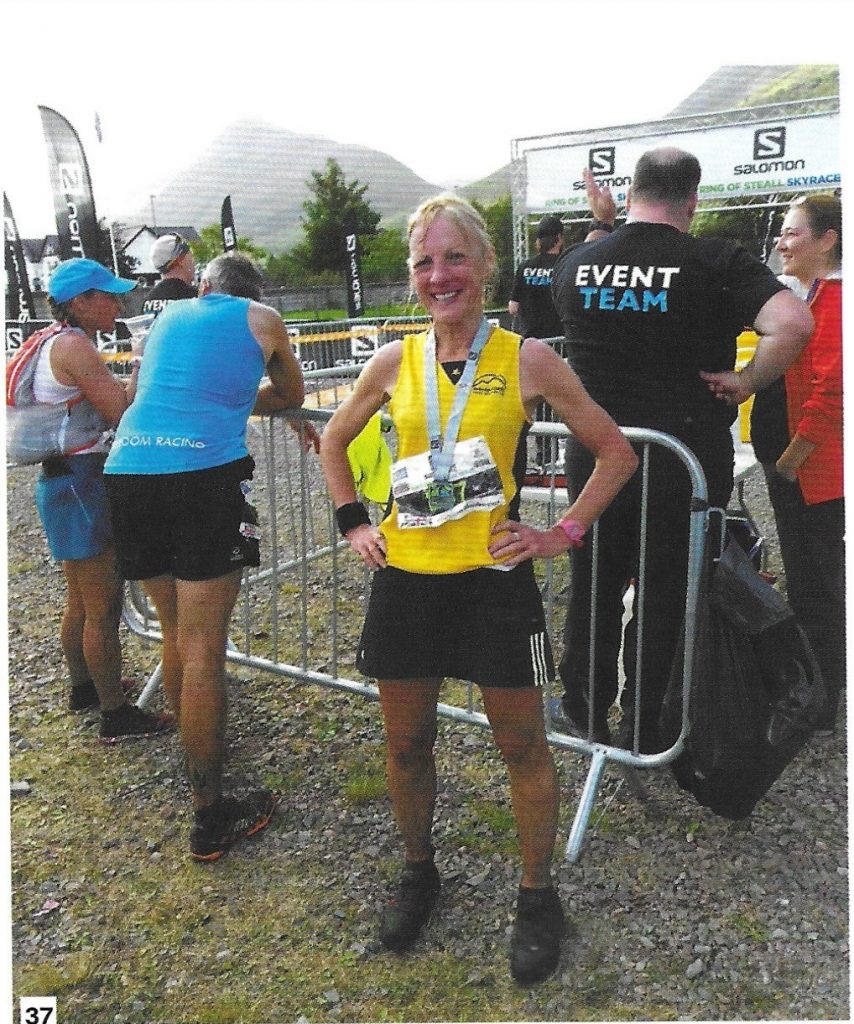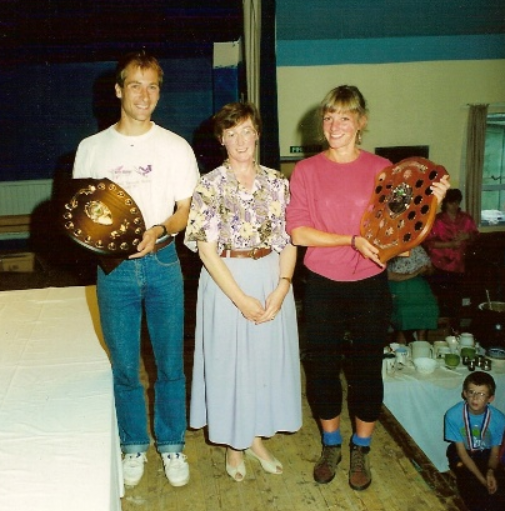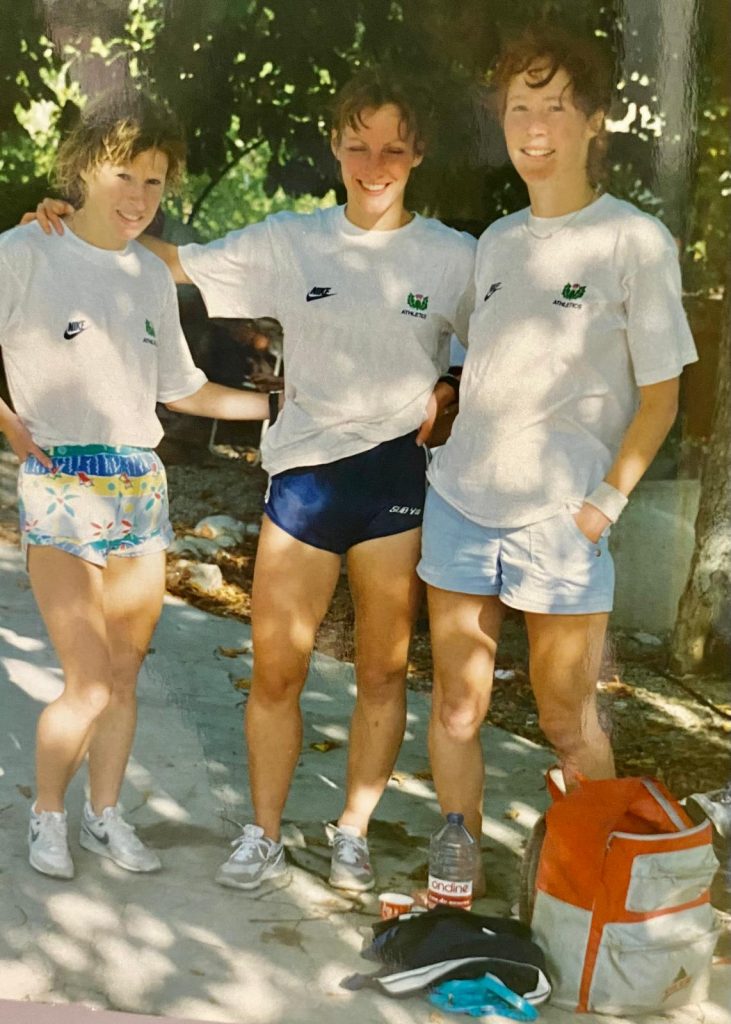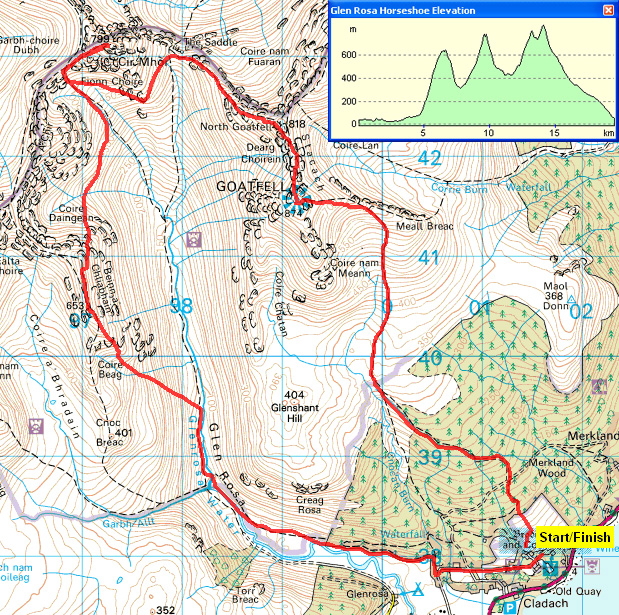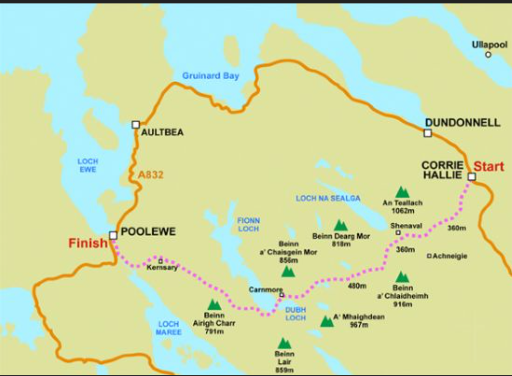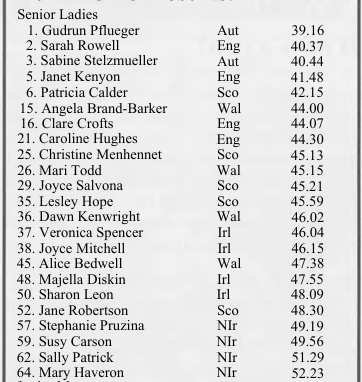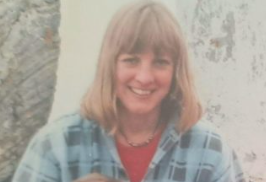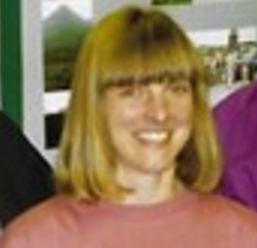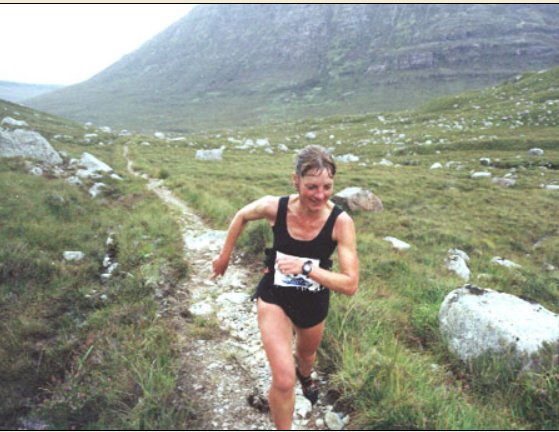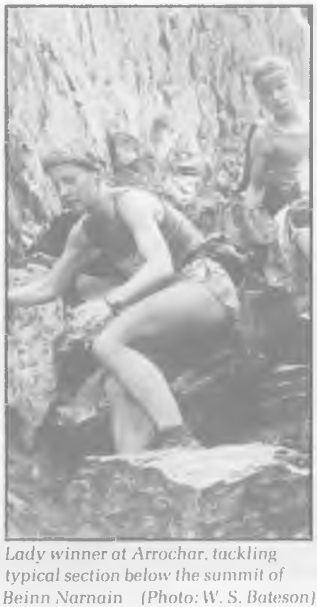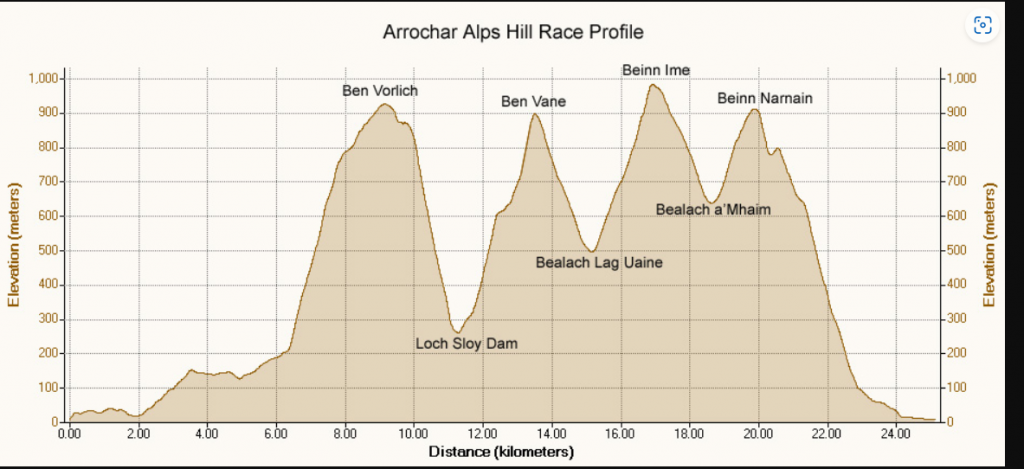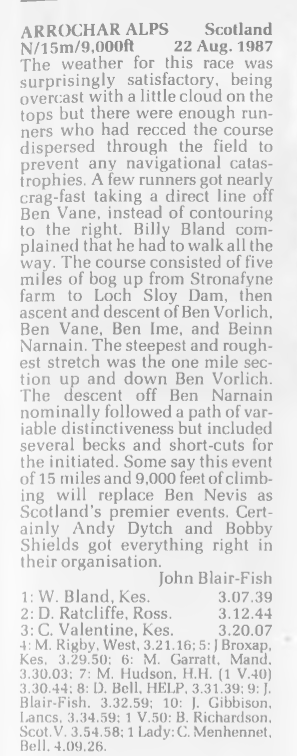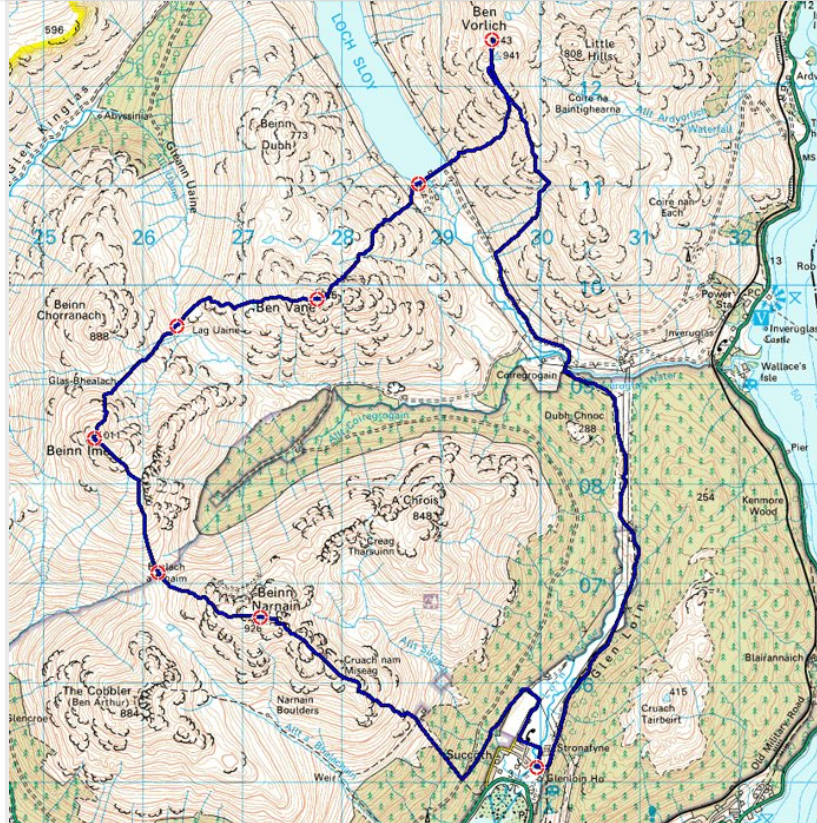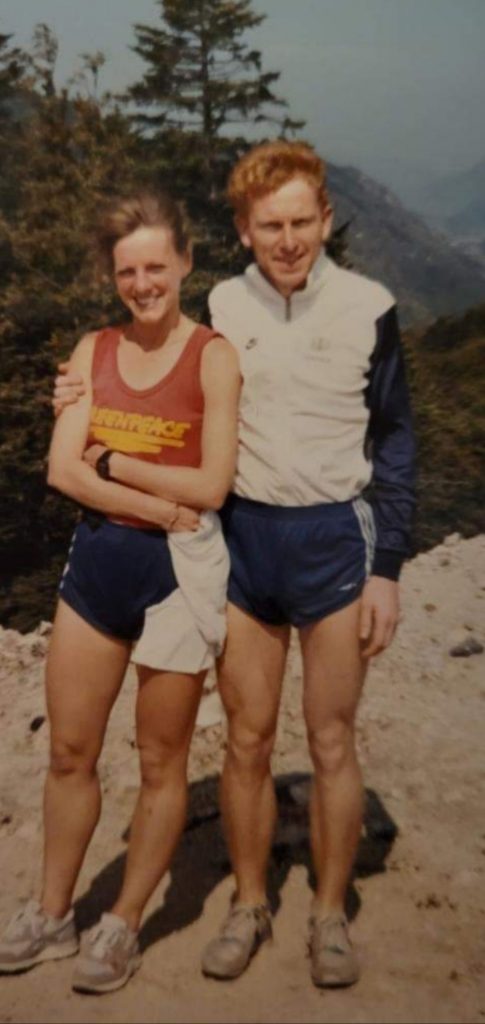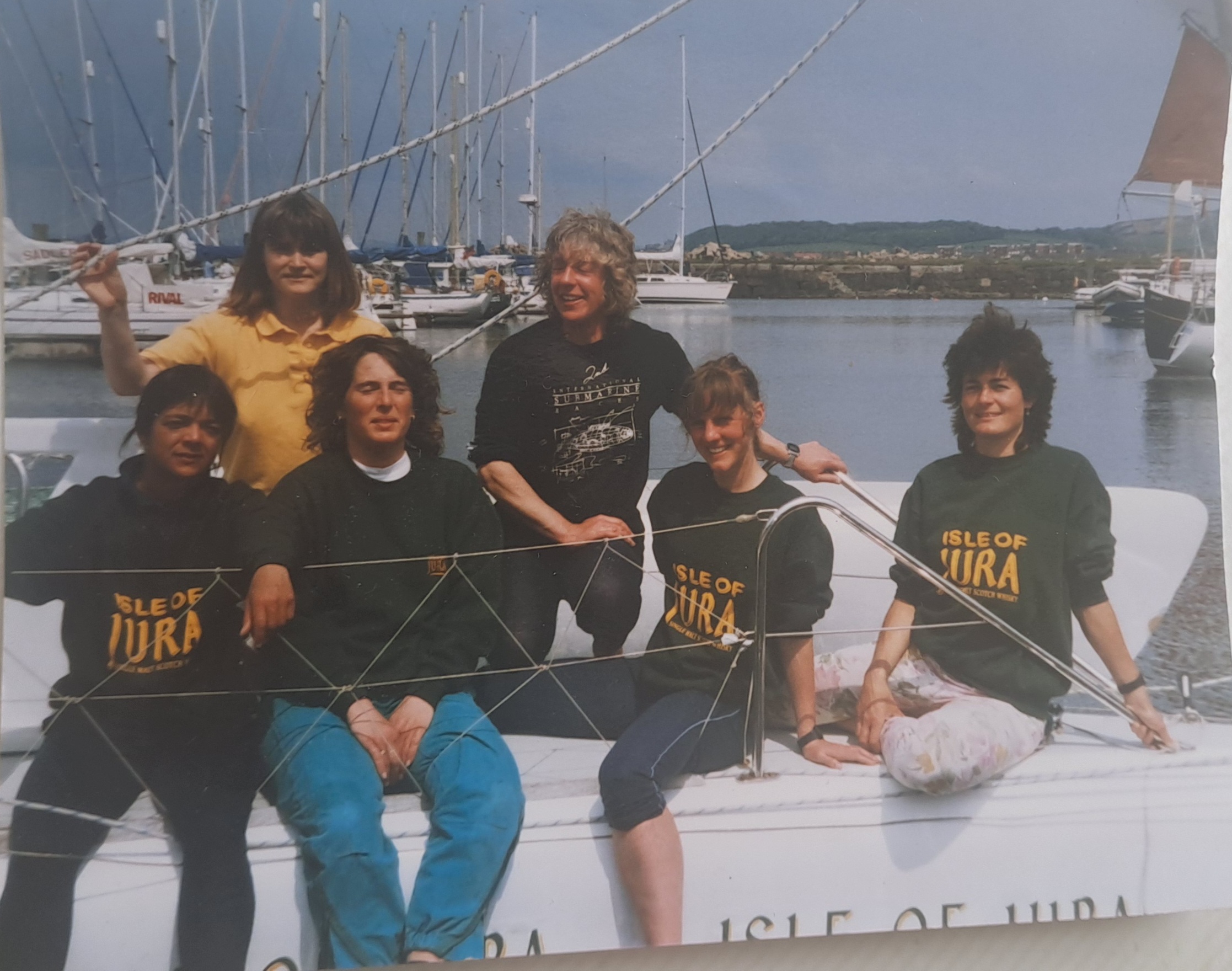
Christine says: Scottish Island Peaks Race the year our all women team came 2nd overall out of a fleet of nearly 70 boats. We were first rounding Mull of Kintyre and up to Sanda ( mainly down to our superfast boat but Helene and I did hold our position in good times on the hill), then wind dies to nothing and we just could not row our big trimaran fast enough – a tiny tri past us and there was no way we cd catch two top Lake District male runners!
______________________________________________________________________________________________________
Christine’s running in the Scottish Island Peaks Race has been mentioned already and a closer look tells us a lot of her and her love of challenges. Most endurance runners have heard of the race, some know people who have taken part in it, but not many know of the difficulties. We should therefor have a look at what was entailed in the event before we evaluate performances.
The Race started in 1983. The first race was a bit different from the one that became popular. It started in Troon and ended in Oban. There is an excellent article by Roger Blamire in “The Fellrunner” of January 1984 which describes the race. You can read it at 1984_January.pdf. The description of the first race is below.

There have been changes and the route was reversed the following year and now follows the route described on the current race website,
“The race starts in Oban with a short hill run, then a sail to Salen on Mull, run over Ben More, sail to Craighouse on Jura, run the Paps, sail to Arran, run Goat Fell, then sail to Troon. The race takes 3 to 4 days and caters for multihulls, racers, and cruisers. Each team consists of 5 (usually 2 runners and 3 sailors), and there is also an All Rounders class for sailors that can run or runners that can sail, and a class for Youth (with the assistance of a few adults). All runners should have hill navigational experience.” The race starts at noon on a Friday in mid-May. The preview in the “Scotsman” of May 1985 describes the race as follows: “Some 19 yachts start from Oban this afternoon on the 160 mile Scottish Island Peaks Race which finishes in Troon after compulsory stops at Salen in Mull, Craighouse in Jura, and Brodick in Arran. From each yacht two runners will race up and down to McCaig’s Tower at the start and later climb Ben More, the Paps of Jura and Goatfell – a running distance on land of 50 miles and a climbing total of 10,000 feet, Boats have to me moved under sail or oars and engines are not allowed, and in last year’s calms some crews plied the oars for 10 hours and more.”
Then comes the question, how did the runners get the boats to take them from island to island? Was it the race organisers who had a list of willing sailors, or the governing body or how was it done? Christine herself tells us: “Us lot (as competitive runners in the know!) used to hunt down the faster boats – so usually mutual consent. Those new to the race would apply as runners looking for yacht or yachts looking for runners”.
The competitors had to be very fit hill runners, had to be good navigators, be adaptable enough to deal with changing weather conditions, be good oarsmen if need be and be able to find a boat and – what it doesn’t say in the big print is that the runners must carry a sleeping bag, orange survival bag, waterproofs, fleece, tracksters, hat, gloves, map, compass and food! As far as choosing a boat was concerned, if it were a very fast boat – they had to be able to persuade the owner to choose them rather than another team. Asking quite a lot.
How did Christine get into the event in the first place?
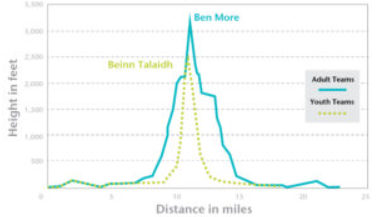
Mull Run Route showing race profile
She tells us that back in the early 1980’s her good friend Ali Coghill who worked at the Inverclyde Sports Centre encouraged her to enter the Scottish Island Peaks Race as part of an all women team using her mountaineering skills, marathon running experience and sailing experience. 1984 was a year of hard training and they used Christine’s father’s boat which he kindly entrusted to them – a Contessa 32 footer. The race started on Friday, 17th May and her running partner was Lesley Kirkwood who also worked at the Clachaig. They competed in 1984 and competed well. This developed a passion for the race that was to last – as we will see – for three and a half decades.
There were different types of hazard over the years as far as the yachts were concerned but the runners had their own problems to contend with – weather, including thick mist, rain, navigational difficulties and so on. They all added to the challenge of the event.
The race started on 17th May in 1985.. It was not all plain sailing though and the Scotsman reported on Tuesday 21st May – “All the yachts and crews taking part in the third annual Scottish Island Peaks Race on the West Coast were known to be safe last night. At different stages in the race which began from Oban on Friday, two yachts were missing, and one fired a distress flare and had to be rescued by Campbeltown life-boat, Three other boats retired because of bad weather.”
By 1987 it had become the Tiso Mountain Peaks race and the starting date was 15th May. The result as published in the “Fellrunner” is below which unfortunately fails to give more than the first three boats and the fastest (all male) times.;
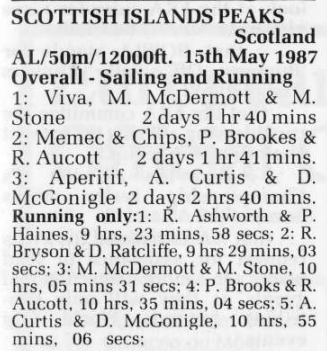
After only one year, Tiso gave way to Bruichladdich as sponsors of the event in May 1988 and the preview in the Oban Times of 12th May told us that sponsorship had been taken over by Islay malt company Bruichladdich for the event to take place between May 20th to 22nd with 38 teams taking part – a third more than the previous year. Tom Haley, the company’s marketing director commented on the quality of competitors and mentioned in particular that fact that two of this year’s competitors were the Everest – Katmandu record holders. It was actually Helene who was the record holder but accompanied by Alison Wright.
After the race the same paper commented further on the sponsor’s all-women team by giving the names of the runners and commenting on the runners from the third placed “Two Hoots” team. “Oban Bay on Friday bristled with masts at the start of the race which saw 76 runners making a quick dash from the South Pier round Pulpit Hill then up George Street to the Esplanade where they joined their yachts for the first leg to Mull. The sponsor’s entry, Bruichladdich, had the added advantage of two runners of the highest calibre: Christine Menhennet and Helene Diamantides, the current Everest-base Katmandu world record holders. Throughout the race winds varied from a 30 knot blow to a flat calm which favoured the lighter craft and the crew of Two Hoots finished exhausted, having rowed 40 miles in 14 hours with only 10 minutes breaks. Two Hoots runners, Brian Potts and Andy Dytch had the fastest aggregate mountain run times.
This was to be only one half of an amazing double for Christine that year with barely a month between two such races. The second was in far-away Tasmania. At Easter 1989, on the other side of the world, a new event called the Health Australia Tasmanian Three Peaks race appeared for the first time. It was almost identical to the Scottish race and had an obvious attraction for Scots prepared to travel. Christine was indeed prepared to travel and she tells us: I had heard of the Tasmanian Peaks Race through Martin Stone ( endurance/fell runner) and Curly Mills ( a founder of SIPR); Helene and I were going to be partners; we got sponsorship from Bruichladdich and the Surveying Company my husband then worked for – MDA; flights and reccie week’s car hire paid for. With 3 weeks to go Helene sustained a bad injury ( Achilles if I remember) and I had to find some one else who was fit enough at that point to deal with the distances ( first leg 40 miles). Helene had met Betty in Nepal. Betty was in training for the West Highland Way race – she had never sailed but was up for an adventure; we did about 3 long runs together – then flew to Taz! We got on great with each other and with our macho team of Tasmanian sailors, and we ran our socks off, beating the other team of women runners and many of the male teams. Our deep keeled boat could not take one vital short cut in the race so we slipped overall position to I think mid fleet. I’ll never forget running across the stunning Wine Glass Bay, the scent of gum trees and the squawk of cuckaburras!
The race that year (1990) started on Good Friday (13th April) and Christine her running partner Betty Hall were on board a 13 metre monohull called Cascade among the 23 boats starting the race. By the end of the race they were 7th boat to finish and in a time of 3 days 3 hours and 35 minutes. The Fell Runner for June 1990 said: “Despite carrying a Channel 9 TV Crew around, runners Christine Menhennet and Betty Hall had the outstanding running performance to be the fourth fastest runners.” Carrying the Scottish flag with considerable pride to be fourth fastest of 23 boats who only had 8 women runners in total. Note the “had the outstanding running performance” comment.
The Scottish Island Peaks Race that year were on 17th May, 1990. Extracts from the preview of the race in the Glasgow Herald under the headline of:
MOLLS OF KINTYRE CAN SHOW MEN THE WAY HOME
tell us that “More than 50 craft, a record entry and representing the highest quality in the eight-year history of the event, are scheduled to start at noon. The yachts must flirt with the tidal race at Corryvreckan, which at its most malign will boil and take control of craft even as big as 30ft – about a quarter of the entry in this race. The bravest may even try to harness its power, riding it to take a shortcut as they make for the southernmost tip of Jura. By the time the survivors reach Troon Marina on Sunday the yachts will have covered at least 160 miles, while the two runners on board each will have raced more than 60 miles with climbs totalling 11,500 feet – that is how it looks on the map, but over some of Scotland’s hardest terrain, it works out at roughly the equivalent of three marathons.” and
“Also in action are female runners, including Glasgow landscape gardener Chris Menhennet and Mount Everest veteran Helen Diamantides. It gives great affront to male entrants to have this duo gallop past them on the hills, especially when they do so wearing fishnet tights and feather boas, the self-styled Molls of Kintyre.”
The “Molls of Kintyre title came from a trophy presented by Helene and herself to the first all-women team in the hope that it would encourage female participation. It was called the Molls of Kintyre because they had competed that year in fishnet tights and feather boas!
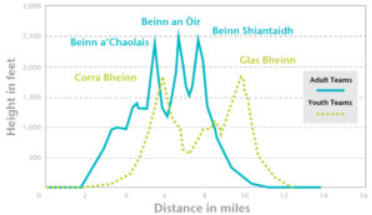
Jura Profile
There is a detailed coverage of the Scottish race in “Scotland’s Runner” of July, 1990 which can be found at
http://salroadrunningandcrosscountrymedalists.co.uk/Archive/Scotland’s%20Runner/SR%20No%2047.pdf
The Boat that Christine and Helene were to sail in in 1993 – Severalle’s Challenge – was in the race but the runners for it were Martin Stone and Michael McDermott. Their progress (Martin and Michael’s) during the race was like every crew slowed considerably by the calm conditions requiring a lot of rowing by the five crew members. The women’s progress was described as follows:
On Mull: The women’s pair of Helene Diamantides and Christine Menhennet recorded a particularly good time of 3:59:59 to best many of the men’s pairs.
On Jura: For the women Diamantides and Menhennet were well ahead with an impressive 4:01:40
On Arran: By this stage many of the boats were retiring, exhausted from rowing, and simply because they ran out of time and had to get back to work. The Bruichladdich Cheetah, carrying Diamantides and Menhennet, was one of these, and pulled out so Diamantides could be sure to get to a Monday afternoon exam. Sadly they had to do so after reaching Arran before completing the final run.”
It had been a superb performance on the first two islands, and one of which they could be justly proud.
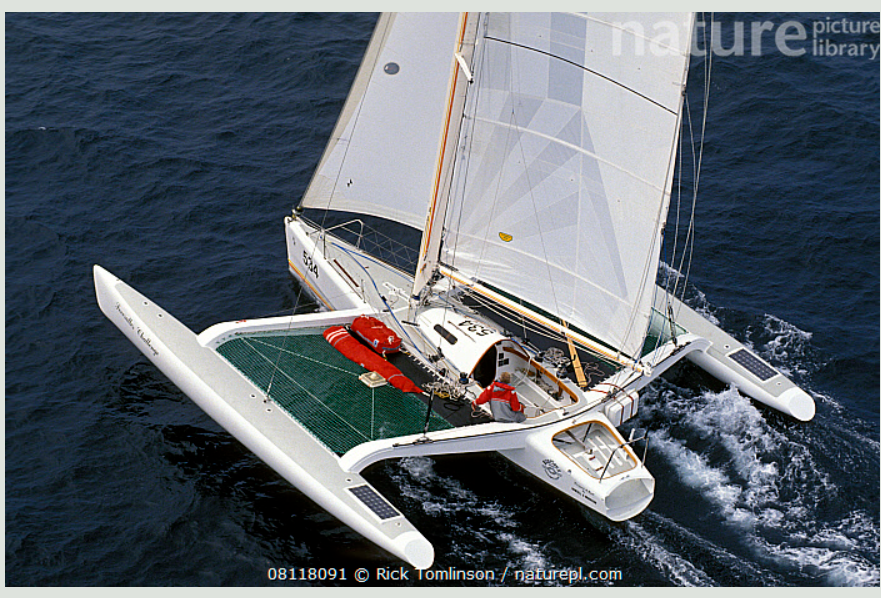
Severalle’s Challenge
By 1993 they, Christine and Helene, were a well known double act and the preview in the “Scotsman” of 18th May that year is reproduced below since it gives a good picture of the race as a whole. Under the following headline it read:
FIERCE AMBITION OF THE MOLLS OF KINTYRE: WOMEN’S TEAM FACE ONE OF THE GREAT TESTS FOR RUNNERS AND SAILORS.
Stephanie Merry has successfully completed round-Britain and transatlantic yacht races and Helene Diamantides is in the Guinness Book of Records for her mountain-running achievements, but this Friday they will team up for their greatest challenge yet in the Scottish Islands Peaks Race.
Both have tackled the annual Hebridean odyssey many times before, pitting their talents and strengths against the forbidding mountain heights and treacherous tidal waters of the islands. The race covers 160 miles of coastal sailing, visiting Mull, Jura and Arran, where two of the crew of five must run 60 miles across five summits totalling 11,000 feet of climbing. It is a test of endurance few could survive but in the male-dominated worlds of offshore yachting and mountain racing Merry and Diamantides intend to achieve the previously unthinkable. With an all-female crew on the trimaran Severalles Challenge they aim to win outright.
When they leave Oban harbour on Friday they will be aboard a pounds 100,000 yacht which has won the race twice and was purpose-built to do so. The millionaire businessman, Dick Skipworth, who is currently indulging another of his passions by racing his vintage Jaguar on the Continent, has sailed the 36ft trimaran to many victories and offered it to an ecstatic Merry, giving the women’s team a realistic chance of victory.
A 43-year-old lecturer in mechanical engineering at Southampton University, Merry is an experienced offshore racer and has competed in the race four times with an all-female crew though she denies being anti- male. ‘I’ve raced in many mixed crews but am often the only lady as it is very difficult for women to get the necessary experience. Most skippers prefer men for their strength so I like to give women the chance to race. They get on better, aren’t afraid to ask each other for help and are more supportive. Egos don’t get in the way of teamwork.’
For crew she selected Gaye Sarma and Heidi Bell, and the choice of runners was easy. Diamantides has won international mountain races as far afield as Cameroon and Borneo and last year won the 220-mile Dragon’s Back race, beating the world’s best male endurance runners after five days’ racing across the Welsh mountains. Her partner will be Christine Menhennet and between them they have won all this year’s long Scottish hill races. Menhennet recently won the Ben Lomond race and is in the Scottish national team.
Together they hold the women’s records for all the runs to the summits of Ben More on Mull, the Paps of Jura and Goat Fell on Arran, and as veterans know what to expect. Storms and seasickness, rowing when becalmed, landings on slippery, seaweed-covered rocks and trackless terrain are all familiar hazards but the faster yacht makes the task harder. ‘To win we may have to do three 20-mile runs in 36 hours,’ says Diamantides, ‘and the noise and motion of the boat allow little rest. It’s like sitting in a bidet and having buckets of water thrown over you and is the only yacht I’ve been on that gives you a kick up the backside when they hoist the sails. It just takes off.’
Merry views the yacht differently. ‘It has everything you could want, 1,000 square feet of sail, satellite navigation, four batteries with solar charges, even sliding rowing seats. It’s superbly designed and is so fast sailing it is very, very exciting, especially in this race. Crossing the Atlantic is just a journey from A to B but here you’ve got fierce tides, rocks, whirlpools, fickle weather and rounding the Mull of Kintyre to cope with.’
In previous races Merry has suffered with poorly equipped yachts while Menhennet and Diamantides have been grounded, rowed to exhaustion, seen the skipper fall overboard and rounded the Mull only to be pushed back by the tide and forced to do it again. Since then they have been known as the Molls of Kintyre and that name is on a trophy they donated for the fastest women runners. This weekend they aim to win it back and help Merry and crew to victory.”
That was quite a write-up so how did the five women deal with it when the race started in Oban? The “Scotsman” said briefly on the Monday:
“Light winds plagued much of the Scottish Island Peaks Race. Last night only three boats had arrived at Troon Marina, having had to spend long hours rowing and sailing to make progress towards the finish. First to finish at Troon was the 27 foot American build Trimaran Tri Harda skippered by owner Nic Slocum who held off the powerful purpose-built 36 foot trimaran Severalle’s Challenge which was sailed by an all-girl crew.” Having read pre-race that the “all-girl crew” had been skippered by Steph with Helene and Christine as the runners, we knew that they had done very well indeed.
How did the women themselves feel about it? Christine is quoted in “Voices From The Hills” as saying “In 1993 Helene and I were part of another all-women team taking part in the SIPR. Steph Murray was our skipper again and our yacht was the super-fast trimaran Severalle’s Challenge, kindly lent to us by the owner, There were about 60 participating boats that year and we rounded the Mull of Kintyre in first overall position! The wind died and we had to row to Lamlash as a result of which we were passed by the eventual winners, rowing a much lighter boat. Nonetheless, an all-women team were second in to the finish at Troon and we were fifth overall on the running stages out of nearly 50 running teams.”
The result as published in The Fellrunner of October 1993 was as follows:
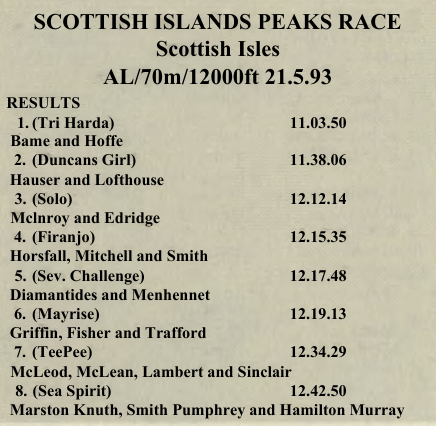
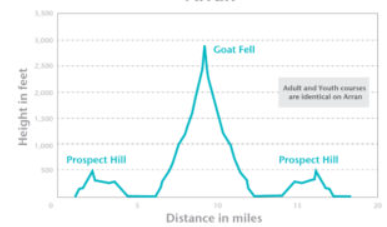
Arran Profile
All-in-all, 1993 was a good year for her – she was also selected to run for Scotland in the WMRA Championships in Gap in France.
Christine continued to compete in this race where the sponsors changed, the team pairings altered from year to year for various reasons such as availability or injury, and where the fastest boats were sought after by the best athletes. The standard of athlete competing was high – the Ladies such as Helen and Christine were not the only women taking party and the wonderful Angela Mudge was also roped in to take part. On the men’s side Mark Rigby and Terry Mitchell were both members of winning pairs. The names of the boats also often brought a smile to the face – HeeBeeJeeBee, Kaos, Eezie Ozie, Two Hoots and Third Degree were among them. What did the runners find attractive in the event?
Curly Mills spoke to the ‘Scotsman’ of 19th May, 1995 saying: “It all adds up to a supreme test of fitness, tactics and teamwork in an event which has to retain a special atmosphere. It is a fun event and as far as we can, we try and keep a light-hearted attitude towards it, though, because of the treacherous waters and severe country, we have to be conscious of the dangers. For me, the attraction of the event is that it is an extreme experience. In modern life there are very few occasions when you work absolutely flat out at anything. Here it is just down to your own muscle and brain. I suppose it is a bit like warfare without the nasty parts. On board, for instance, runners, besides resting after their exertions, often help the crew sail to their next dropping off point – or worse. Often it is flat calm at night, so you have to row The runners know if they help us get the boats in five minutes earlier it saves them having to run five minutes faster, so there is a balance to be struck.”
It was a tough challenge for Christine and the runners. Unlike hill races of whatever distance, even events like the Wilderness Challenge never although the weather before and during the race can make a massive distance, the Island Peaks involves two different techniques and the tasks that are imposed on the competitors are not the usual – for instance not all endurance athletes have arms able to help row a boat on a calm night. The remarks above explain one man’s attitude but I suspect that the feelings expressed apply to many more.
*
There is a two page article on the SIPR from a not-very-competitive runner in the Fellrunner at this link 1996_June.pdf . It goes into some detail from the point of view of a first time runner in the event and is a good indication that the range of participants – as distinct from competitors – who took part in the event.
